#call it the symbolism of women as creators of life and death
Text
ive said this before, but i still dont know how to make it clear enough: I Want Less Death & The Maiden. And More Death As A Maiden
#. 🦴#call it latin languages referring to death in the feminine (la muerte a morte la mort etc)#call it the symbolism of women as creators of life and death#but death as a woman will always be more interesting to me than another beauty and the beast hades and persephone retelling
12 notes
·
View notes
Text
The Shunned Yoni
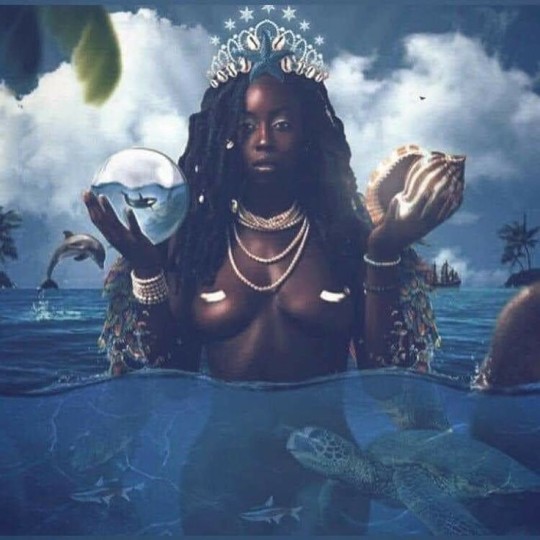
We all know creation and birth stems from somewhere. From the most sacred gateways that nature created The womb vagina or ; the female genitalia which symbolizes generative power. The woman is delicate, graceful and loving at same time, forceful, impactful, insightful, and a creator. How can we call this realm mother earth and not think women were here first or the creators only a true creator could create and be humble while their creation becomes egotistical while claiming to be the original archetype From their mesmerizing eyes calming vice diplomatic minds soft touch hypnotic walk and seductive aura. From the spiritual abyss, every angle, precise detail was made to flow with the oceans waves, their calming nature can settle the storms, or be fierce as the storm. So much history and powers lays beneath these ripples in the sea. As the tear drops of sorrow and betrayal fall upon the blueish lake. Shunned no more, openish enters the heart, truth reveals the veil, expressiveness leads way, acceptance is here to stay.
As an active plot to pacify her & her waters, her descendants, her priestesses, her daughters, her initiates, her love, but most disrespectfully her waters. She was made as an extension, and as the image of god. She started in darkness, she is the water they poisoned. Look inside, and you'll see that you are purely her mirror, because you are her. She was demonized, and in the end turned against. Hell hath no fury like a black woman scorned.


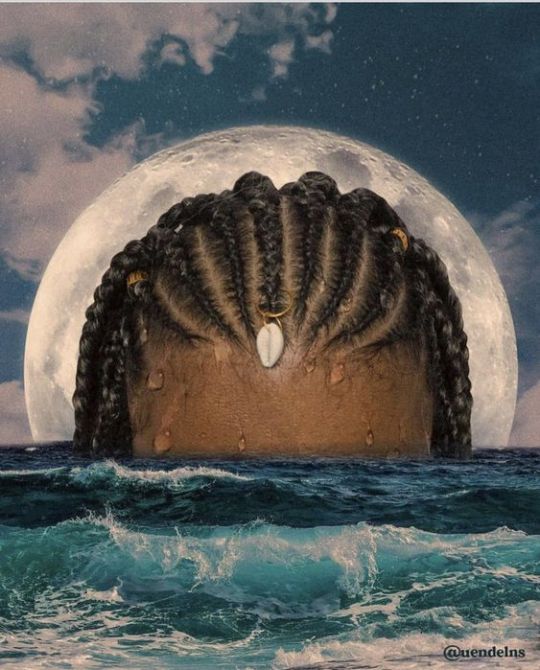
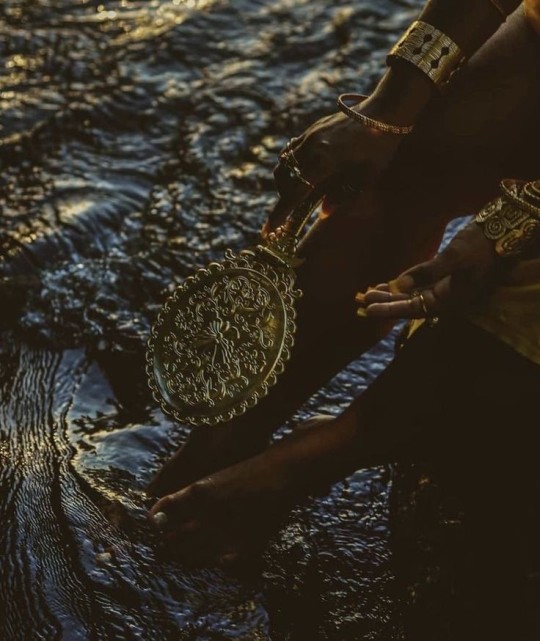

The deepest part in you resides, this is the sacrum area. You hold future generations and civilizations within you yet they seek to destroy and disrespect you. Let there be no mistake, that you are the force and the life way past than what science can understand or comprehend. Do you remember? Do you remember your throne, and those you taught. In the end, they turned against you. Used your teachings for their new world, and white washed yours away just for a seat on your throne. There's a part of you that lays deep in the water waiting to be awakened and take back what's hers. They took the seed of life and realized they could not imitate because they did not have it within them. There will be a storm that awakens that seed, she is abrupt and comes like nothing you've ever seen before. Deep Down, we as women have been taught to hide our sexuality or that it was a bad thing. However, these days feminine sexuality has been more accepted, and broadcasted for everyone to see. In a way, this is good but also bad, because the sacredness of this has been corrupted and the true meaning is lost in ignorance.

In the womb, we grow, and develop in water for up to 10 months. Our bodies are mostly water, and the planet we live on resembles this. All Life must be formed through liquid, it is the most fertile, and feminine. Think of a plant without water, and sun, but water especially nothing will sprout. Whether it be alchemy, or astrology, the most feminine elements will be water, and earth. water is the 1st element, signifying its power. water can heal, and destroy you. The yoni is simply a portal, entering into a sea of memory, and mysteries. When we look into the mystery of outer space, galaxies, stars, plane-ts, and black holes. Then you begin to look within yourself, your own body, you see the sayings, "As above, so below" " As within, so without", and the most telling " Your body is a temple". You see the answer manifest, and replicate inside of you.
The power of the yoni, is nothing to be taken lightly, and is actually a symbol of life and death. If all women collectively agreed to stop reproducing, that would simply be the end. For this reason, there has been a demonization placed upon women whether that be our bodies, hair, features, etc.
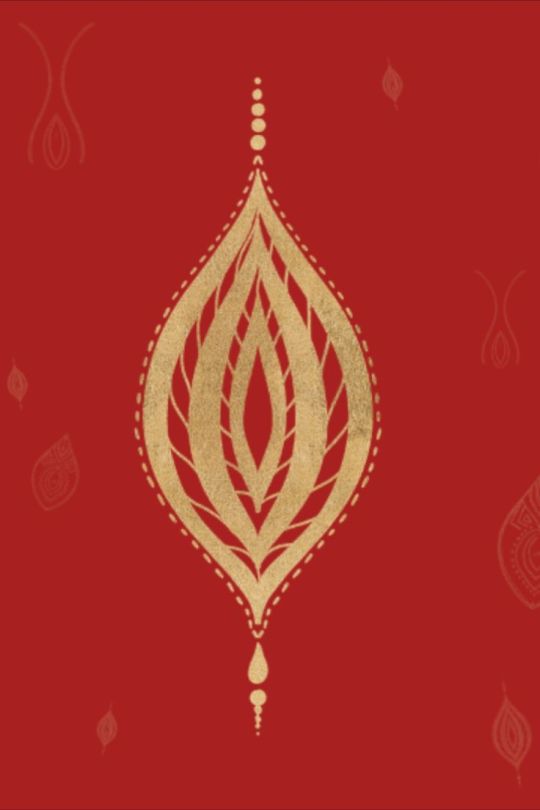


There is such a huge attack on the water spirits right now. Looking back to the astrological take on this matter, the sign pisces is the last and final sign of the zodiac. This is a water sign. In christianity, the symbol "Vesica Pisces" is a very prominent symbol representing Jesus Christ who "walked on water." Ironically, this symbol represents a fish, and the pisces symbol is a fish. If you look closer at the shape of this symbol, you'll realize this looks similar to the vaginal canal. Pisces is known to be the yin most, and the darkness which the creator resides in. In sacred geometry, there is the flower of life and seed of life, both using the symbol vesica pisces within those shapes. Within all of this, we begin the covering up of our primordial origins, within christianity, and many modern-day religions. the presence of priestesses, goddesses, empresses, and queens have been stripped and burned away. We know by now that the source of creativity, love, and rhythm comes from depths of the darkest waters, which pure yin. So what does that say about the bible or the said authors. let alone, the books, and the most important teachings that have been taken out of the bible, and also many others. This wasn't the only crime, but while erasing her presence, they tried to take away your magic, your creativity, and use your sexuality (which is your ability to manifest, and create) for their gain. As I ponder upon this, I am compelled to question: How many chapters of HIStory are indeed tales of men, or could they be the untold stories of women masked in masculine guise...
To close this out, let your mystical minds wander.... Think about how, in Christianity, to get baptized, you are laid into the waters to be reborn or cleansed from sin. Or, how a woman's water breaks signifying life & birth, or how you couldn't survive without water for more than 2 days.... Things like these make you wonder....



𝐓𝐡𝐞 𝐌𝐚𝐬𝐭𝐞𝐫𝐥𝐢𝐬𝐭
𝐎𝐮𝐫 𝐏𝐫𝐞𝐯𝐢𝐨𝐮𝐬 𝐏𝐨𝐬𝐭
𝑶𝒖𝒓 𝑷𝒂𝒈𝒆𝒔: 𝐏𝐫𝐢𝐧𝐳 𝐕𝐞𝐧𝐮𝐳 || 𝐌𝐨𝐨𝐧 𝐃𝐞𝐯𝐢

#astro community#astrology chart#astrology content#astro notes#forbidden astrology#hot astrology#spirituality#spiritual community#astro blog#spiritualgrowth#spiritual awakening#water initiate
55 notes
·
View notes
Text

The Fossorian Church of the One Below is the state religion of the Kingdom of Mindolach, having emerged as a unified entity nearly two thousand years ago.
Fossorians worship the One Below, a deity they believe to dwell in a vast, beautiful hall deep beneath the surface. Fossorians believe that the One was the first being ever to exist, and created the world around Himself to create a place where other life could flourish. He is said to be the creator of all souls.
Fossorians worship the One Below for providing the things needed to sustain life, especially agricultural products. The symbol of the Church, the octofoil, represents these blessings.
Fossorians believe that, in exchange for providing man with sustenance, they must provide the One with nourishment as well, in the form of their own bodies upon death. Fossorians are therefore buried after they die, and cremation is strictly prohibited except by way of immolation as punishment for a crime, as not only does it deny the One a meal, it also destroys the soul.
This is important, for Fossorians believe that after death, the soul travels to the One's hall for rest and respite. After finishing His consumption of the body - full decay - the One returns the soul to the surface in a new body to live a new life. Based on a person's deeds and virtues in life, the One may choose to elevate the soul's social status in its new life, or lower it to the status of a beast.
The One Below is opposed by the Five Above - Blight, Brutality, Avarice, Sloth, and Death. These are said to be aspects of the One which He cleaved from Himself to purify his being, and now exist as the rulers of all wicked spirits, delighting in leading humans astray from the virtuous path desired by the One.
Priests of the Fossorian Church are called Fossors, and are tied to a specific geographical area through their assignment to the various temples in Mindolach. These are typically built underground or tunneled into caves, to be closer to the One. Ordination is restricted to men, although women have roles to play in Fossorian temples as temple maidens, who are in charge of liturgical music and managing temple finances. Fossors are educated and expected to retain some medical knowledge, as they are also the community's gravediggers, morticians, and, in smaller communities, doctors as well. They read from the Floretia, the Fossorian holy book, which contains both the canonical texts of the faith as well as a collection of commentaries and addenda written by particularly learned and holy men.
The Church is headed by the Voice of the One. Upon death, the Voice's soul is believed to reincarnate into the body of the next Voice, who will then come to lead the Church upon his majority. It is an unbroken chain of reincarnation going back for centuries. While the new Voice is being found, and during his minority, the Second Hand of the Church leads it in his stead.
36 notes
·
View notes
Note
I don’t understand the concept of Original Sin. It doesn’t make sense to me and even as a teenager I didn’t understand this concept (I’m an adult now). Can I still be a good Christian (I was raised Roman Catholic) even if I don’t believe in/agree with the concept of Original Sin? If accepting the concept of Original Sin is required for me to be a good Christian/Catholic, could you please help me understand it?
The concept of Original Sin is important in the Catholic faith. If we decide to start cherry picking what we want to choose to believe vs what God teaches us with while wanting to align with the Church’s teachings, it can become a dangerous path that invite us to start doubting more about God’s Word. Perhaps many of us don’t know what the Church officially says, because perhaps we were never taught. It’s ok- it’s time we learn. Let’s have a look..
“The Fall From Grace
"The second Creation story is in Genesis 2:4–3:24. This is the story of Adam and Eve and the Garden of Eden. Unlike the first Creation story, in the second story, man is created first, then all the animals, and finally woman. Like the first Creation story, it teaches that God gave us a spiritual soul by the symbolic action of breathing life into Adam (2:7). It also teaches that man and woman need each other to be complete (2:23), and that human beings are to cultivate and care for creation (2:15). But then it goes even further.
In the second Creation story, God places Adam and Eve in the Garden of Eden. The Garden of Eden symbolizes the ideal relationship that God intended to have with human beings. In the garden there is no pain, no death, and no shame. Adam and Eve see God face-to-face. They are in a perfect state of holiness and justice. They are friends with God and from that friendship flows that happiness.
But then something terrible happened. Eve was tempted by a serpent to eat some fruit from the tree of knowledge of good and evil (3:1-6). God’s only command to Adam and Eve was to not eat from this tree (2:16-17). Eve gave the fruit to Adam, and he also ate it. They had disobeyed God and committed the first sin. They lost their trust in God and His goodness. The tree of knowledge of good and evil symbolizes the limits that human beings have as creatures. We must recognize those limits and accept them with trust. If we try to exceed those limits, we are in a sense setting ourselves against God, or at least we aren’t believing God’s word about what our limits are. This was Adam and Eve’s sin, which is sometimes simply called the fall.
Adam and Eve’s sin had immediate consequences. They knew the shame of having disobeyed God and tried to cover it up with a makeshift clothing and by hiding from God in the garden. They start the blame game: Adam blames Eve and Eve blames the serpent. God announces further consequences. Childbirth will be a painful experience. The relationship between men and women will be filled with tension and marked by domination (3:16). The earth will no longer freely give its bounty, so human beings will have to work hard at tilling the soil for their food (3:17-19). And finally, Adam and Eve and all their descendants will experience death, for “you are dust, / and to dust you shall return” (3:19).
Thus, Adam and Eve’s sin has consequences, not just for themselves but for all their descendants, which means all of us! The harmony that should exist between people, the harmony that should exist between human beings and nature, and the harmony that should exist between people and God has been wounded. The Catholic Church explains the impact of Adam and Eve’s sin in its teaching of original sin. Much of the Old Testament shows the continuing influence of sin, starting with the story of Cain killing Abel…” - The Catholic Faith Handbook For Youth, pages 51-53.
.......
“397 Man, tempted by the devil, let his trust in his Creator die in his heart and, abusing his freedom, disobeyed God’s command. This is what man’s first sin consisted of. All subsequent sin would be disobedience toward God and lack of trust in his goodness.” - #397, page 112. Catechism of the Catholic Church, second edition.
“398 In that sin man preferred himself to God and by that very act scorned him. He chose himself over and against God, against the requirements of his creaturely status and therefore against his own good. Constituted in a state of holiness, man was destined to be fully “divnized” by God in glory. Seduced by the devil, he wanted to “be like God,” but “without God, before God, and not in accordance with God.”” - 398, page 112. Catechism of the Catholic Church, second edition.
“399 Scripture portrays the tragic consequences of this first disobedience. Adam and Eve immediately lose the grace of original holiness. They become afraid of the God of whom they have conceived a distorted image—that of a God jealous of of his progress.” - #399, page 112. Catechism of the Catholic Church, second edition.
“400 The harmony in which they had found themselves, thanks to original justice, is now destroyed: the control of the soul’s spiritual faculties over the body is shattered; the union of man and woman becomes subject to tensions, their relations henceforth marked by lust and domination. Harmony with creation is broken: visible creation has become alien and hostile to man. Because of man, creation is now subject “to its bondage and decay.” Finally, the consequence explicitly foretold for this disobedience will come true: man will “return to the ground,” for out of it he was taken. Death makes an entrance into human history.” - #400, page 112. Catechism of the Catholic Church, second edition.
…..
“403 Following St. Paul, the Church has always taught that the overwhelming misery which oppresses men and their inclination toward evil and death cannot be understood apart from their connection with Adam’s sin and the fact that he has transmitted to us a sin with which we are all born afflicted, a sin which is the “death of the soul.” Because of this certainty of faith, the Church baptizes for the remission of sins even tiny infants who have not committed personal sin.” - #403, pages 113-114. Catechism of the Catholic Church, second edition.
“404 How did the sin of Adam become the sin of all his descendants? Te whole human race is in Adam “as one body of one man.” By this “unity of the human race” all men are implicated in Adam’s sin, as all are implicated in Christ’s justice. Still, the transmission of original sin is a mystery that we cannot fully understand. But we do know by Revelation that Adam had received original holiness and justice not for himself alone, but for all human nature. By yielding to the tempter, Adam and Eve committed a personal sin, but this sin affected the human nature that they would then transmit in a fallen state. It is a sin which will be transmitted by propagation to all mankind, that is, by transmission of a human nature deprived of original holiness and justice. And that is why original sin is called “sin” only in an analogical: it is a sin “contracted” and not “committed”——a state and not an act.” - #404, page 114. Catechism of the Catholic Church, second edition.
“405 Although it is proper to each individual, original sin does not have the character of personal fault in any of Adam’s descendants. It is a deprivation of original holiness and justice, but human nature has not been totally corrupted: it is wounded in the natural powers proper to it; subject to ignorance, suffering, and the domination of death; and inclination to sin—-an inclination to evil that is called “concupiscence.” Baptism, by imparting the life of Christ’s grace, erases original sin and turns a man back toward God, but the consequences for nature, weakened and inclined to evil, persist in man and summon him to spiritual battle.” - #405, page 114. Catechism of the Catholic Church, second edition.
youtube
Effects of Original Sin - By Archbishop Fulton Sheen
22 notes
·
View notes
Text
Culture of Tattoo Ainu:
The modern Ainu term for tattooing is nuye meaning “to carve” and hence “to tattoo” and “to write”, or more literally, sinuye “to carve oneself”. The old term for tattoo was anchi-piri (anchi, “obsidian”; piri, “cut”).
For the Ainu, tattooing was exclusive to females, as was the profession of tattooist. According to mythological accounts, tattoo was brought to earth by the “ancestral mother” of the Ainu Okikurumi Turesh Machi who was the younger sister of the creator god Okikurumi.
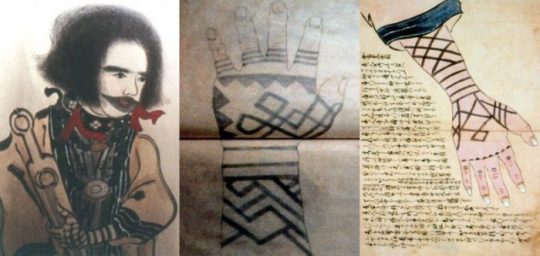
Because tattooing represented an ancestral custom derived from one common female ancestress, it was continued down through the centuries in the matrilineal line. Viewing tattoo practices through the lens of kinship, it is not surprising that the position of tattoo artist was customarily performed by grandmothers or maternal aunts who were called “Tattoo Aunts” or simply “Tattoo Women”.
The completed lip tattoos of women were significant in regards to Ainu perceptions of life experience. First, these tattoos were believed to repel evil spirits from entering the body (mouth) and causing sickness or misfortune. Secondly, the lip tattoos indicated that a woman had reached maturity and was ready for marriage. And finally, lip tattoos assured the woman life after death in the place of her deceased ancestors.
Apart from lip tattoos, however, Ainu women wore several other tattoo marks on their arms and hands usually consisting of curvilinear and geometric designs. These motifs, which were begun as early as the fifth or sixth year, were intended to protect young girls from evil spirits. One motif, the braidform pattern, consisting of two rectilinear stripes braided side by side linked to a special motif, represents a kind of band also used for tying the dead for burial. Other marks were placed on various parts of the body as charms against diseases like painful rheumatism.

As with burial cords, the braid-like weave structure of women’s plaited girdles called upsor-kut were embodied with a similarly powerful supernatural “magic” symbolizing not only a woman’s virtue, but her “soul strength”. “bosom girdles” were objects worn underneath the woman’s outer garment (attush) and kept “secret” from Ainu men. They were made of woven flax or native hemp varying in length and width and in the number of strands. Composed of either three, five, or seven plaited cords (sometimes alternating with intersecting or overlapping lozenges or chevrons), they closely resemble the tattoo motifs that appear on the arms of Ainu women.

“The tattoo marks are placed especially upon the lips and arms, because they are the most conspicuous parts. They are put there in order to frighten away the demon of disease. Now the wives of the heavenly deities are every one of them thus tattooed, so that when the demons come, and find that the Ainu women are marked in the same way, they mistake them for goddesses, and forthwith flee away.”
However, tattoos and girdles were connected on yet another, more metaphysical level. The Ainu believed that the fire goddess Fuchi provided Ainu women with the original plans for constructing the sacred upsor girdles. As noted earlier, Fuchi was also symbolized by the soot used in tattooing practice thereby linking the traditions of tattooing and girdling to Ainu mythological thought. And because each type of girdle was associated with a particular kamuy, it can be suggested that particular tattoos were perhaps associated with specific deities: “the wives of the deities were tattooed in a similar fashion as the Ainu women, so that when evil demons would see it, they would mistake the women for deities and therefore stay away”.
Interestingly, girdles were received upon completion of a girl’s lip tattooing just before or on the occasion of marriage. The design specifications of the girdle were passed down by the girl’s mother; she instructed her daughter how to make the girdle and warned that if it was ever exposed to any male, great misfortune would come to her and the family.

Eight types of upsor with each form related to a different line of matrilineal pedigree and associated with several animal and spirit deities (kamuy), such as the killer whale, bear, and wolf crests. Thus aristocratic women, especially the daughters of chiefs (kotan), wore more powerfully charged girdles than common women, because their ancestry connected them more closely to the kamuy. Munro also observed that the daughters of Ainu chiefs were tattooed on the arms before any other women in the village, suggesting that these types of tattoos conferred prestige and social status to the wearer. In this sense, tattoos and girdles appear to be functionally related.
Frogs and Tattoo
It is curious to remark in connection with tattooing that the Ainu fancy they can see tattoo marks on frogs resembling those made on the women. The following legend concerning the origin of these creatures is peculiar, to say the least, for it tells us that their first parent was neither more nor less than a woman who was cursed by God, and had her bodily form changed, on account of her great wickedness.
He metamorphosed her as a punishment, and her human spirit was turned into that of a demon. All that was left to show that it had once been a woman, were very slight traces of tattoo marks, which may still be seen, if one will take the trouble to look carefully on the legs (hands) of the frog.
'In ancient times there was a man and a woman who became husband and wife. After the first few months they did not get on well together, because the woman was discovered to be a bad character, and proved undutiful to her husband. She was also disobedient to her parents, and in the end bewitched them so that they both died. In course of time she married no less than six husbands, every one of whom she soon killed. God observed all this, and was very angry with her, so that He punished her by turning her into a frog, and throwing her far away into a marsh.
At the same time He said to her: 'O thou wicked woman, I indeed made thee good in the beginning, but thou hast lived an abominable and iniquitous life; thou hast not only slain thy father and mother and husband, but others besides. I am therefore now going to turn thee into a frog; thou shalt henceforth live in the marshes, lakes, and ponds, and thou shalt become a fiend. Thou shalt spawn young frogs, and hop about amid the slime of the most filthy places. If thou dost venture into the dwellings of men they will without more ado knock thee on the head, and throw thy dead carcase away."
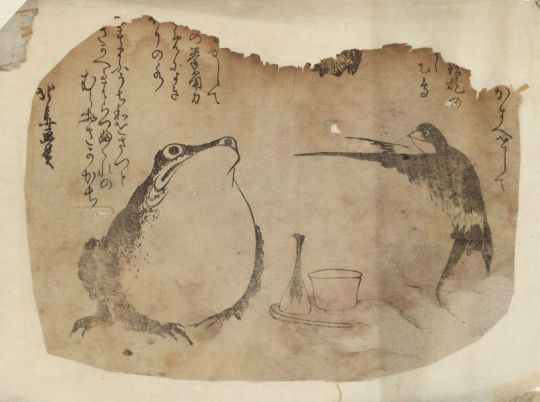
'So spake God. And this then is a true account of the origin of frogs; any person will find, if he examines them closely, that their feet are slightly tattooed, like the fingers of a woman. It is because a woman was the ancestor of these creatures that they have the marks of the tattoo left. Now, there are some people who, out of sheer pity, say in so many words that frogs are divine; but they are not so in reality, for they are demons, and something akin to ghosts. Yet, as they were once human, and followed the customs of men and women, they still go to the Japanese of the main island every winter and do their marketing, and when they return eat, drink, and make merry in their dwelling-places. This is the noise one hears in the spring when they cry, Ooat, ooat!
-América Briceño.
4 notes
·
View notes
Text
The Binary Artwork of Delita Martin

Amelia Jones's book, "Seeing Differently: A history and theory of identification and the visual arts," explores two prominent binary art theories discussed in Chapter 2: Individualism (pg.22) and the concept of Self vs. Otherness (pg.4). The art of Delita Martin represents the art theories of Individualism and the concept of Self vs.Otherness in a binary proposition. Martin creates spiritual artwork that mixes and layers various methods of artistic expression into a “holding” space that converges the visible with the invisible. A spiritual and physical manifestation she calls a “veilscape”. The artwork consist of patterns and symbols that converge and show a “connection between the waking world and the spirit world” (NMWA.com)
Individualism emphasizes the artist as an individual creator with personal vision forming a binary relationship between the self and the artwork. Delita Martin's "Quilted Angel 2015" artwork represents the binary relationship between her own individual creative expression and her spiritual identity as a black woman. Race itself is a binary of projected and internalized identifications (pg. 44)
The concept of Self vs.Otherness, explores the binary interplay between the self and self-identity and the perception of others. Delita Martin's "Quilted Angel 2015" also has the binary nature of Self vs. Otherness. The artwork depicts the binary relationship between the artist's self-identity as a woman and her spiritual identity as a spirit woman conveyed through the use of circles (feminine) and blue (spirituality).
Both Individualism and Self vs.Otherness highlight identity as a binary nature of art. Individualism focuses on the binary uniqueness of the artist's identity and their creative expression. In contrast, Self vs. Otherness is more about the binary relationship between the artist's self-identity and perceptions of others. Delita Martin intertwines the binary relationships of gender, race, life and death in her artwork that conveys the complex dialectical nature of relations between self and others that are often “downplayed or ignored” (pg. 37).

REFERENCES
by: Andria Jones
Representing Women -UNCG - Fall 23

1 note
·
View note
Text
"What is a 2000's feminist?
Well, a 2000's feminist is a female who has decide that life without a man is stronger than with one, they are anti love, anti-romance and anti-men acting like men (acts of chivalry, public displays on love affirmations and men romantical pursuing true love.).
Why is a 2000's feminist like this?
A feminist in this generation is not like the feminists of the old generations.
They may call themselves feminists, but they are not.
These are hurt woman who have decided to become "woke feminists" due to the trying to get with every ones future spouse but the one God has chosen for them.
They have spent their time dancing from guy to guy playing house with multiple partners who are not their future spouse and have decided that that's that and given up on men completely after using everyone else's future spouse and expecting them to treat them a particular way that only their future spouse has the anointing to deal with.
This is why there are so many women who hate men; is they are expecting other men to be what they are not... The only one who is able to love you besides God, your family and you is the man God has anointed to be your husband. Of course, you're not going to find these qualities in a man who is not your future spouse. God has someone special for everyone, but we are not created to have multiple partners. Anyone who has dated around always says when they are married that after dating, they were left with heaps on baggage and brokenness that only God could heal. It is not Gods will for us to go around on a power trip trying to dominate people, slip into people's dms and find love on our own.
The product of trying to find love on our own is brokenness; only Jesus Christ can lead, direct and show you your future spouse.
And above all else Jesus Christ is and should be the first person you run to for love because only the creator and the product of love and designer of your heart can give love.
A while ago i read this 2000's feminists quote, "What is a woman without a man? Historically stronger...Cleopatra....list of women in history without men who were in power."
This quote often shows up in my feed, and this is the voice of most women today, but what these women don't understand is that the women they list on this list were not strong and they wore pain in their heart and never found love or healing. For example, Cleopatra was not strong, she was broken, raise in a broke society, a lawless society without real love, she didn't believe in love and power was all she knew. To gain the power she had, she played games with the hearts on men, snaked her way into all the power she held, and in the end, she ended up dying by the way she lived... A snake being killed by a snake. In the bible the snake is referred as, a symbolization of temptation, deception, and spiritual danger, as implied in Genesis 3. Also, in the New Testament, the devil is described as a “serpent of old” who deceives eve into spiritual death. A world without love is a world without Jesus and his plan for your life. And the only serpent who tried to take love away from this earth originally was satan. And as for Cleopatra she chose to treat men as a step to step on and a life to use to again power as most people would describe as being a snake. If you look at the traits of a snake, you will have to acknowledge that the snake when faced with its prey lifts its body up stares you right in the eyes, trying to charm and tempt you before killing or trying to bite at you. In the same way Cleopatra rose onto power looked at the men that she could use to gain more power and attacked their weakness to gain the strength. In the same way she met her end the same way she lived. There is no strength from this tragic story but only sadness, pain and hurt.
Women without the man they are lonely, hurt beings but without God in their lives they are nothing. We are nothing without Jesus Christ. God created a man for a woman and a woman for a man. In the Garden of Eden, God saw that it was not good for man to be alone; so, God created man a helper.
" So the Lord God caused the man to fall into a deep sleep; and while he was sleeping, he took one of the man’s ribs[g] and then closed up the place with flesh. 22 Then the Lord God made a woman from the rib[h] he had taken out of the man, and he brought her to the man.
23 The man said,
“This is now bone of my bones
and flesh of my flesh;
she shall be called ‘woman,’
for she was taken out of man.”" - Genesis 2: 21 -23.
From the beginning God created Adam for Eve and Eve For Adam, one man for one woman, one woman for one man.
Without man, woman historically would be nothing because woman came out of man... As for why the name of man is in the name of woman.
And as another historical reason woman can't live without men... You would have to take a big look at Jesus Christ, he came to this earth born as a man but who was still God giving and laying his life down for humanity in the name of love.
“For there is one God and one Mediator between God and men, the Man Christ Jesus, who gave Himself a ransom for all, to be testified in due time, for which I was appointed a preacher and an apostle—I am speaking the truth in Christ and not lying—a teacher of the Gentiles in faith and truth.” 1 Timothy 2:5-7.
To reject all men is an idea from satan, to keep a woman from giving their hearts not only to their future spouse that God has created especially for them also to be keep women away from giving their hearts to Jesus Christ. It is not from God that we live without love in our hearts; that is satans main plan to eradicate all life and love. Don't let the pain of this world stop you from finding Jesus Christ and stop rejecting love because God really does love you and he will never hurt, leave or abandon you."
Faith Ferguson
0 notes
Photo
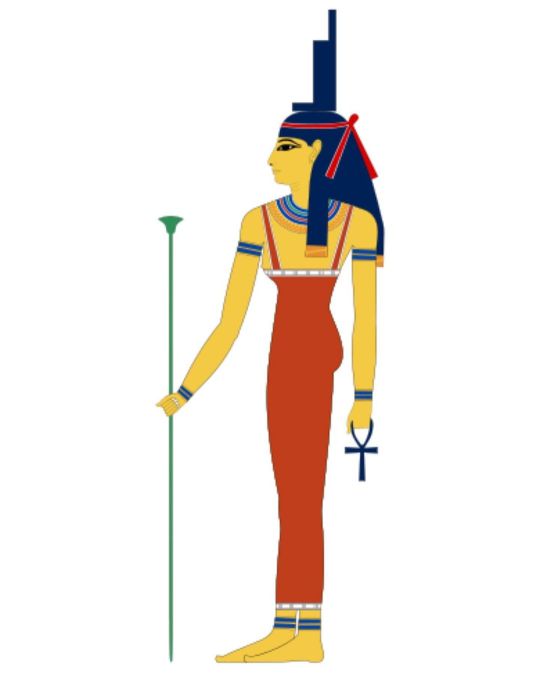
This Cancer New Moon brings me into a place of reflection about the womb and birthing. As such, I’m drawn to the ancient wisdom embodied in the divinity of Auset. Since the divine feminine principle always leads, I’m going to guess that Auset is the first child born from the passionate union of Nut (Mother Sky) and Geb (Father Earth). I will introduce all their “children”, the Gods and Goddesses, in turn; but the key is to realise that this language of God/desses, children, feminine, masculine is limited and limiting. English is a colonising language 🤷🏾♀️ binaries are colonial because all is one and the origin is androgynous. . . Where was I? Yes, Auset. You can identify her by the crown she wears which resembles a throne. I believe this throne symbolises taking our seat as the creators of reality. A journey that Beyoncé’s Black Is King so beautifully speaks to; and that is a related story for another day. In one hand Auset holds an Ankh (the symbol of eternal life and the womb); and in the other she holds a staff (the symbol of royal lineage and authority). Auset is a badass. Loyal, loving, compassionate and full of integrity to divine order and harmony. She calls us into our divine feminine. She governs fertility or creative abundance and (alongside her sister Nebt-het), she conducts funerary rights. Remember how Mother Mary and Mary Magdalene anointed and dressed Jesus in the cave? That’s a related story but for another day. Circling back to the zeitgeist under this Cancer New Moon and the ancient wisdom it brings to mind … Auset teaches me that birth and death are one in the same - powerful portals in the never ending cycle of life. Women+ and Femmes alone hold ultimate authority over these portals. Even in death we experience rebirth. This constant flow of spirit into and out of physical form means no one ever really dies, not in the colonial English language sense. Death happens throughout our lives as We die to old versions of ourselves in order to be reborn. And ceremony is the balm that eases the grief of this constant unfolding into our next iteration. Life is eternal. Life has no opposite. Death is a portal to rebirth. https://www.instagram.com/p/CfZ4YNEhH3_/?igshid=NGJjMDIxMWI=
0 notes
Text
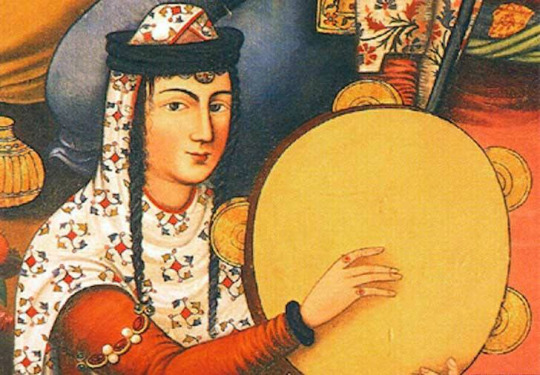
When The Drummers Were Women
By Layne Redmond
Yes, guys, there was a time in our history when the primary percussionists and drummers were women. The first named drummer in history was a Mesopotamian priestess named Lipushiau. She lived in the city-state of Ur in 2380 BC, which at that time had conquered all the surrounding city-states. She was the spiritual, financial and administrative head of the Ekishnugal, the most important temple in Ur dedicated to the moon god, Nanna-Suen. Her emblem of office was the balag-di, a small round frame drum used to lead liturgical chanting. In 2380 BC, Lipushiau ruled!
From the civilizations of Anatolia (Old Turkey), Mesopotamia, Egypt, Greece and Rome, the Goddess and the frame drum emerge as the core trance and mystical religious traditions. The frame drum was once at the center of the oldest rave like gatherings — it was the oldest technology for altering consciousness. The mystery rites would last for days at a time with nonstop drumming and dancing. Get this in perspective — this was church. Quite a different religious experience than I had growing up! A frame drum is defined by the diameter of the drumhead being much larger than the depth of its shell. The shells range in depth from 2" to at most 6". They range in diameter from 4" to 30". Most of these drums are portable and can be held in one hand.
The frame drum most often has a skin on only one side but sometimes it may have skins stretched across both sides. Bells or jingling and rattling implements may be attached to the inside rim, and in ancient times were believed to add to the drum’s power to purify, dispel and summon. Very often the drums were painted red, the color of blood, or sometimes green, the color of vegetation, the primordial colors of life. Mystical designs and symbols might also be painted on the skin head or the wooden frame. Threads or ribbons knotted with ritual prayers or chanting often hung from them.
Although this frame drum is similar in appearance to the shaman’s drum found throughout Asia and North America, there is a major difference in how they are played. The shaman’s drum is struck with a bone, horn or stick. The Mediterranean frame drum is played with the bare hands. While striking a drum with a stick gives a single deep resonant sound, finger techniques allow more variety: a deep, open tone, a slap, a high-pitched rim sound, or a soft brushing sound. This difference in stroke technique has led to differences in construction. The inner edge of the rim of the Mediterranean frame drum is often beveled and its skin is usually thinner, to enhance the sounds produced by fingers and hands. Hand or stick? I have not been able to determine which technique is older - the shaman’s drum played with a stick or the frame drum played with bare hands.
The use and basic constructions of the drums are so similar that they probably both grew from the same root techniques of altering consciousness. In every ancient Mediterranean civilization I studied, it was a goddess who transmitted to humans the gift of making music. In Sumer and Mesopotamia it was Inanna and Ishtar; in Egypt it was Hathor; in Greece, the nine-fold goddess called the Muse. Musical, artistic and poetic inspiration was always thought to spring from the Divine Feminine. One of the main techniques for connecting to this power of inspiration was drumming.
The drum was the means our ancestors used to summon the goddess and also the instrument through which she spoke. The drumming priestess was the intermediary between divine and human realms. Aligning herself with sacred rhythms, she acted as summoner and transformer, invoking divine energy and transmitting it to the community.
The earliest known depiction of any drum was painted on a shrine room wall in 5600 BC in a Neolithic city in what is now Turkey. The shrine room wall depicts a group of ecstatically dancing figures, some of which appear to have percussion instruments. A band of human figures clad in leopard skins play various percussion instruments as they dance ecstatically around a large bull. One figure holds a horn-shaped instrument in one hand and a frame drum in the other. Other figures carry what look like shakers or rattles, as well as bowed instruments similar to the Brazilian berimbau. The excavating archaeologist, James Mellaart, has unearthed numerous other shrines in this city honoring a great goddess, and he believes that primarily priestesses tended these shrines. To date, the wall painting is our oldest evidence of a goddess-based tradition in which the frame drum was used in ecstatic rituals.
From 3000 to 2500 BC, written records of the Sumerians describe the goddess Inanna as the creator of the frame drum, along with all other musical instruments. They tell of Inanna’s priestesses who sang and chanted to the rhythms of round and square frame drums. Along with the written texts, numerous figurines of women playing small frame drums have been found. These drumming rituals were carried on in the later worship of Ishtar, Asherah, Ashtoreth, Astarte, and Anat in Mesopotamia, Phoenicia, Palestine and Assyria. Somewhere between 2000 and 1500 BC, the frame drum arrives in Egypt. James Blades reports, “All records from this period (Middle Kingdom) show the performers as women; in fact the whole practice of the art of music appears to have been entirely entrusted to the fair sex, with one notable exception, the god Bes, who is frequently represented with a drum with cylindrical body (frame drum).
”Another text described the priestesses as the composers and choreographers of the music and dance used on religious occasions. In the Cairo Museum there is an actual rectangular double-headed frame drum from 1400 BC that was found in the tomb of a woman named Hatnofer. Also surviving from the Ptolemaic period is the skin head of a frame drum on whose surface is painted a woman playing a frame drum in front of the goddess Isis. The inscription on the drum reads, “Isis, Lady of the Sky, Mistress of the Goddesses.”
It is important to comprehend the significance of women’s control of sacred music and dance in Egypt. Religious ceremonies based on music and dance can synchronize the underlying energy of the mind and directly influence our perceptions of reality. Ritual influences our modes of awareness that both underlie and transcend the normal patterns of consciousness. Rites can be used to rouse and shape group emotion and behavior, developing a continuous shared consciousness. Music vibrationally transmits states of mind directly from consciousness to consciousness. Thus, politically, music can resonate simultaneously on far more levels — emotional, spiritual, intellectual and physical — than can words alone. As music initiates changes in group consciousness, it can affect vast social and economic cycles.
The Biblical lands have also yielded numerous images of women playing the frame drum. Old Testament texts refer to the tambourine as the toph, which as been translated as the timbrel and the tabret. Exodus 15:20, “And Miriam, the prophetess, sister of Aaron and Moses, took a timbrel in her hand, then the women went out after her with timbrels and with dances.” In some legends it is said that Miriam parted the Red Sea with the shamanistic power of her drumming.In Greece, some of the most beautiful representations of the frame drum are found on the red figured vase paintings from the fifth century BC. The frame drum entered Greece from several different directions — from Cyprus, one of the main centers of the cult of Aphrodite where the frame drum was prominent from at least 1000 BC, and also from Crete, where it was used in the rituals of Ariadne, Rhea and Dionysos.
Pre-classical Greece also saw the introduction of the cult of the goddess Cybele, from Western Anatolia. The tympanum, the Greek frame drum, was the main instrument of the maenads, the women initiates, in the worship of Cybele and Dionysos, and the priestesses of Artemis, Demeter and Aphrodite also played them. Both single-headed and double-headed frame drums appear, once again played almost exclusively by women.
The Romans saw the last great flowering of these rites when the religion of Cybele was brought to Rome in April of 204 B.C. She was described as, “Cybele, the All-Begetting Mother, who beat a drum to mark the rhythm of life.” Rome was the cultural center for the mystery religions of Cybele, Dionysos, Isis and Dea Syria — all of which used the frame drum in their ecstatic rituals. These practices flourished until the Roman Empire officially adopted Christianity in the fourth century A.D.
In the ancient world, prayer was an active, trance-inducing combination of chanting, music and dance, and initiates often danced the sacred spiral into the labyrinth. The classic labyrinth is a single path meant for meditative circling. To enter it is to experience a ritual death; to escape from it is to be resurrected. The danced line into the labyrinth was a sacred path into the inner realm of knowing. Dancers holding a rope signifying Ariadne’s thread (that allows participants to find their way in and out of the maze) followed a leader into the labyrinth, spiraling right to left, the direction of death. At the center they turned, dancing out in the direction of evolution and birth, all to the driving rhythms of the frame drums.
Another function of the frame drum was to create a prophetic trance state in which the priestess could foretell the future. The most dramatic mode of prophecy was uttered in inspired rhythmic speech. In the depths of ecstatic trance, the oracle was possessed by the goddess, who rapped in powerful rhymes directly through her lips. The Greek word for this state of transfigured consciousness is enthusiasmos – “within is a god” – the root of our word enthusiasm.
Ecstatic prophecy has many parallels with shamanism. Prophetesses sought inspiration through a number of external stimuli, including fasting, ingesting honey, inhalation of burning herbs or essential oils and intoxication via alcohol or psychotropic plants. Cybele’s priestesses relied most heavily on the trance-inducing properties of music and dance. The rhythms of frame drums, cymbals and flutes moved them towards the consecrated, concentrated state of divine revelation.
The Dionysian rites are the most widely known of all the mystery schools and have an enduring reputation as drunken sexual orgies. This is due to the later descriptions by Christian political leaders to whom the ancient mysteries of the goddess along with ecstatic drumming, dancing and in this century, rock and roll, have been labeled devil worship. Our word “orgy” comes from orgia, derived from the root word meaning “deed.” The term was used for the celebrations following initiation in mysteries, which might or might not include sexual imagery or behavior. Its ancient connotation seems to have been simply “secret rites.” Their aim was the ecstatic transformation of consciousness through rhythmic movement of the body.
Historians have associated the maenads, priestesses of Dionysos and Cybele, with unbridled sensuality and socially uncontrolled behavior. The word maenad means “mad women.” Their erotic longing for union with the Divine found expression in wild, barefoot dances to the primordial music of flute and drums, their unrestrained hair flying wildly about their faces, snakes wrapped around their arms. According to some reports they drank blood and tore wild beasts limb from limb. Not too far out of line from what might take place at a contemporary summer rock festival!
Wine was indeed an important part of the Dionysian mysteries. External stimulants were always used in pursuit of higher consciousness, for divine intoxication with the spirit of the deity. References to drinking blood may actually allude to a communion rite in which the fruit of the grape represented the blood of the deity, as it does today in Christian communion rites.
Mastery of the precise musical rhythms required to align the devotees’ consciousness with divinity suggests a control and sophistication of technique that contradicts the historical image of wanton frenzied women. Creating rhythms powerful enough to move hundreds of people into ecstatic trance states required skill, discipline and endurance.
With the ascendancy of Christianity, Cybele’s great temple in Rome was destroyed, the Vatican was built on the site and the new priesthood banned the priestesses, instruments and music associated with her rites. Not only was the frame drum banned from Christian religious rituals, its use in secular contexts was also frowned upon by the Church, in particular its use by women. The Catholic synod of 576 (commandments of the Fathers, Superiors and Masters) decreed: “Christians are not allowed to teach their daughters singing, the playing of instruments or similar things because, according to their religion, it is neither good nor becoming.
”For 3,000 years women had been the primary percussionists in the ancient world. As Europe pursued this policy of disallowing women to learn music, they effectively barred them from the professions of composing, teaching or performing.
The last 30 years have seen a dramatic rise in the number of professional women musicians, but there are still few women pursuing drumming. Although little is known about the history of frame drums and the women musicians who played them, it is an important part of our percussive history. And the ancient traditions of using drumming for spiritual purposes can point out what we have lost.
At contemporary rock concerts we have all the trappings of ritual without the spiritual purposes. Flashing trance-inducing lights, loud rhythmic sound, chanted and sung words, but often with no higher purpose than to momentarily entertain or to glorify the individual performer. And no matter how much idolization some of these quite gifted musicians attain, they are often driven to attempt to fill the emptiness with drugs and alcohol.
Yet I remember concerts that hinted at the search for wider realms and dimensions of being. The first concert I ever saw was a show by the Monkees. But what blew me away was the opening act — Jimi Hendrix. I had no frame of reference for where he was taking me. I soared with him beyond the known on the piercing sounds and songs of his guitar. Yet in the end he burned and beat that beautiful guitar to pieces. I had experienced something profound and transformative, but it had ended in destruction, leaving me bewildered and yearning for something more. I have spent the rest of my life looking for the pathway into the ecstatic that leaves me transformed, whole and euphoric.
This article was Originally published in DRUM! Magazine’s December 2000 Issue
75 notes
·
View notes
Text
SJM's pinterest board. ACOTAR 6/7.
(No conclusion just suspicious stuff lmao)
Here's a photo i found on SJM's ACOTAR pinterest board:
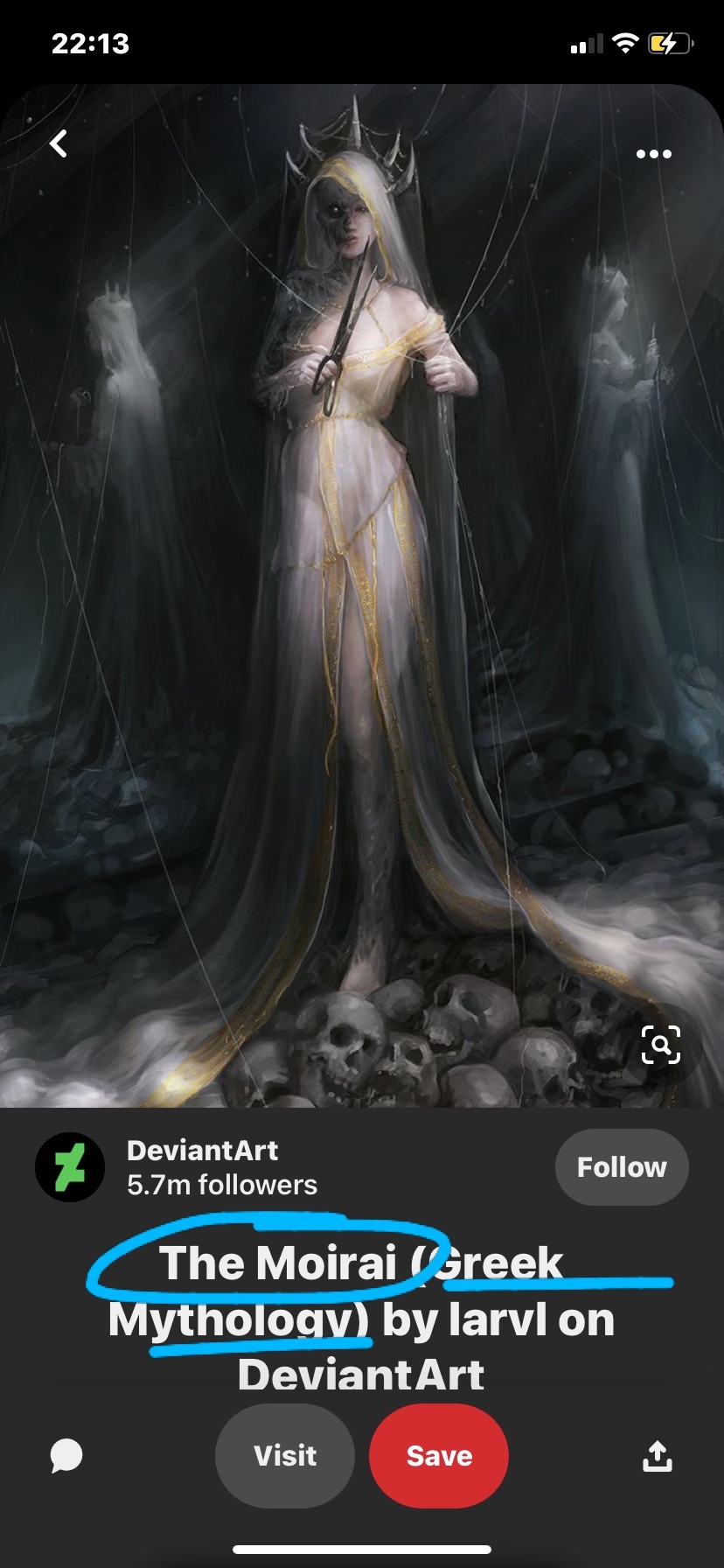
THE MOIRAI (Moirae) were the three goddesses of fate who personified the inescapable destiny of man (and women). The role of the Moirai was to ensure that every being, mortal and divine, lived out their destiny as it was assigned to them by the laws of the universe.
In nearly all mythologies the three Fates, rulers of the past, present and future, are represented and many believe they symbolize the Triple Goddess, Virgin, Mother and Crone (Creator, Preserver and Destroyer).
In Greek mythology, the Moirai—often known in English as the Fates—were the white-robed incarnations of destiny.
“There were at least three dozen priestesses who worked and researched and healed here, though it was nearly impossible to count them when they all wore the same pale robes and so many kept the hoods over their faces.”
Clotho (/ˈkloʊθoʊ/, Greek Κλωθώ, [klɔːtʰɔ̌ː], "spinner") spun the thread of life from her distaff onto her spindle.
(Clotho: the mute priestess at the library)
Lachesis (/ˈlækɪsɪs/, Greek Λάχεσις, [lákʰesis], "allotter" or drawer of lots) measured the thread of life allotted to each person with her measuring rod.
Atropos (/ˈætrəpɒs/, Greek Ἄτροπος, [átropos], "inexorable" or "inevitable", literally "unturning",[13] sometimes called Aisa) was the cutter of the thread of life. She chose the manner of each person's death; and when their time was come, she cut their life-thread with "her abhorred shears". The figure who came to be known as Atropos had her origins in the pre-Greek Mycenaean religion as a daemon or spirit called Aisa. Another important Mycenaean philosophy stressed the subjugation of all events or actions to destiny and the acceptance of the inevitability of the natural order of things; today this is known as fatalism.
The Morrígan or Mórrígan, also known as Morrígu, is a figure from Irish mythology. The name is Mór-Ríoghain in Modern Irish, and it has been translated as "great queen" or "phantom queen".
The Morrígan is mainly associated with war and fate, especially with foretelling doom, death or victory in battle. In this role she often appears as a crow, the badb.[1] She incites warriors to battle and can help bring about victory over their enemies. The Morrígan encourages warriors to do brave deeds, strikes fear into their enemies, and is portrayed washing the bloodstained clothes of those fated to die.[2][3] She is most frequently seen as a goddess of battle and war and has also been seen as a manifestation of the earth- and sovereignty-goddess,[4][5] chiefly representing the goddess's role as guardian of the territory and its people.[6][7]
Mor may derive from an Indo-European root connoting terror, monstrousness cognate with the Old English maere (which survives in the modern English word "nightmare") and the Scandinavian mara and the Old East Slavic "mara" ("nightmare");[14] while rígan translates as "queen".[15][16] This etymological sequence can be reconstructed in the Proto-Celtic language as *Moro-rīganī-s.[17][18] Accordingly, Morrígan is often translated as "Phantom Queen".[16] This is the derivation generally favoured in current scholarship.[19]
The Morrígan is often considered a triple goddess, but this triple nature is ambiguous and inconsistent. The triple appearances are partially due to the Celtic significance of threeness.
(Three is a VERY common number in acotar (might make a whole other post on that))
Could Mor be one of the fates or even something more powerful than them, could she have a bigger part than we thought in the next story with Koschei ?
In the Republic of Plato, the three Moirai sing in unison with the music of the Seirenes. The term "siren song" refers to an appeal that is hard to resist but that, if heeded, will lead to a bad conclusion.
In Greek mythology, the Sirens (Ancient Greek: plural: Seirênes) were dangerous creatures, who lured nearby sailors with their enchanting music and singing voices to shipwreck on the rocky coast of their island. It is also said that they can even charm the winds.
i bet your thinking where tf is this looney going with this....well,
i also found this photo:

Celtic Mythology The GWRAGEDD ANNWN [wives of the underworld]were lake-sirens in Wales. These lovely creatures are known to choose mortal men as their husbands. One legend has it that they live in a sunken city in one of the many lakes in Wales. People claim to have seen towers under water and heard the chiming of bells. In earlier times, there used to be a door in a rock and those who dared enter through it came into a beautiful garden situated on an island in the middle of a lake. In this garden there were luscious fruits, beautiful flowers and the loveliest music, besides many other wonders. Those brave enough to enter were welcomed by the Gwragedd Annwn and were invited to stay as long as they wanted, on the condition that they never took anything back from the garden. One visitor ignored the rule and took a flower home with him. As soon as he left the island, the flower disappeared and he fell unconscious to the ground. From that day on, the door has been firmly closed and none has ever passed through it again.
“My grandmother was a river-nymph who seduced a High Fae male from the Autumn Court.”
Gwyn believes her grandmother to be a river-nymph. Is it possible that she was not but instead a lake siren? We know that Gwyn and Catrin's names are welsh (Lake-Sirens are found in wales) and the spring court has many ties to welsh mythology so is it really that far fetched?

In Celtic and Norse mythology, selkies (also spelled silkies, sylkies, selchies) or selkie folk (Scots: selkie fowk) meaning "seal folk"[a] are mythological beings capable of therianthropy, changing from seal to human form by shedding their skin. They are found in folktales and mythology originating from the Northern Isles of Scotland.
To further back up this, here is another photo of a Selkie woman on SJM's pinterest.
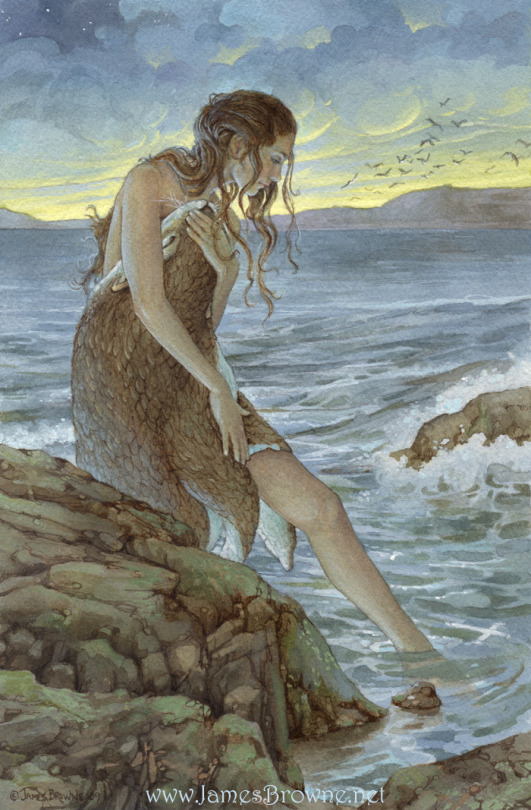
In David Thomson's book The People of the Sea, which chronicles the extensive legends surrounding the Grey Seal within the folklore of rural Scottish and Irish communities, it is the children of male selkies and human women that have webbed toes and fingers. When the webbing is cut, a rough and rigid growth takes its place.
Children born between man and seal-folk may have webbed hands, as in the case of the Shetland mermaid whose children had "a sort of web between their fingers",[25] or "Ursilla" rumoured to have children sired by a male selkie, such that the children had to have the webbing between their fingers and toes made of horny material clipped away intermittently.
“My twin had the webbed fingers of the nymphs—I don’t.”
Once again we see that Catrin posses traits of these water-creatures.
Keep in mind SJM has this on her board - The cover of Celtic folktales which has one story in particular of a 'sea-maiden' whom makes a deal with a mortal man.
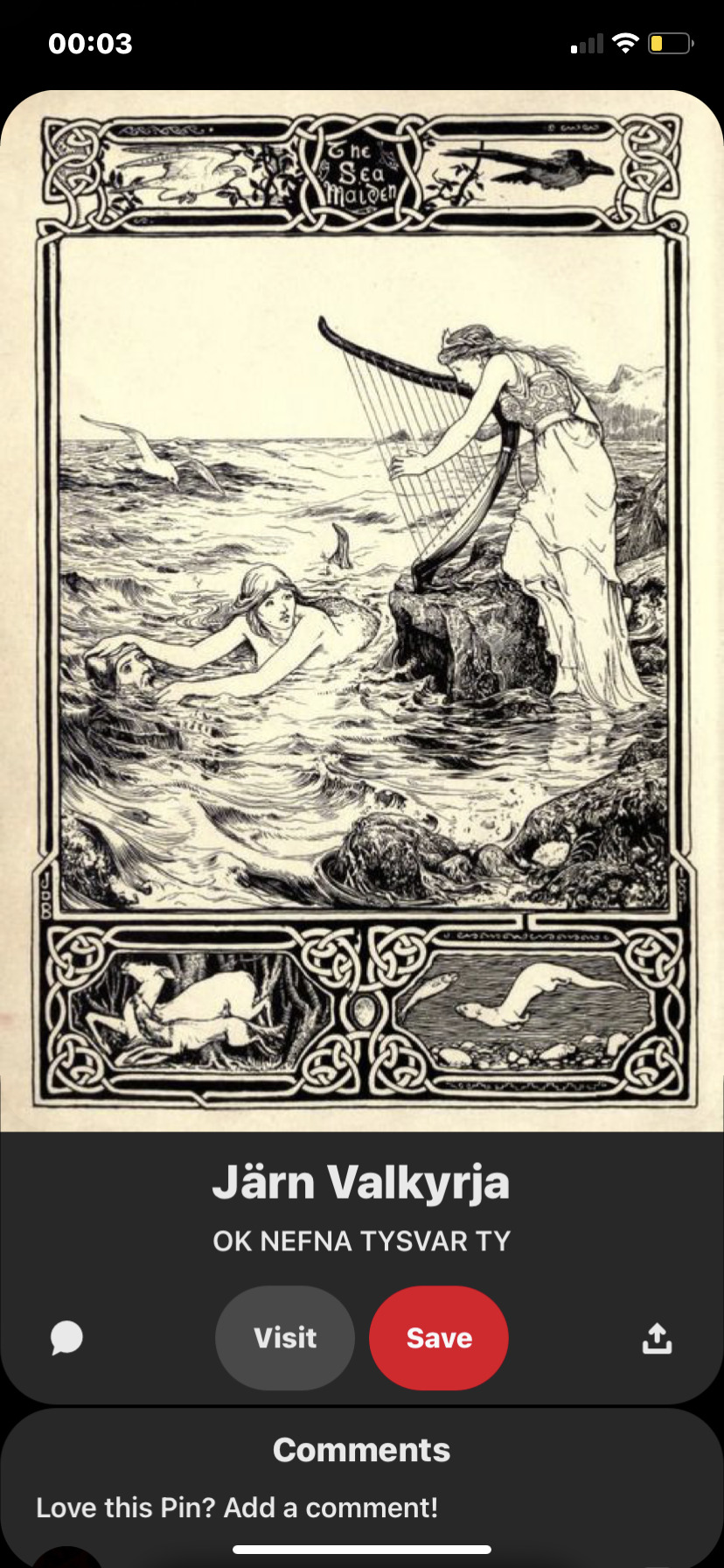
I proceeded to continue searching through the board and found this:
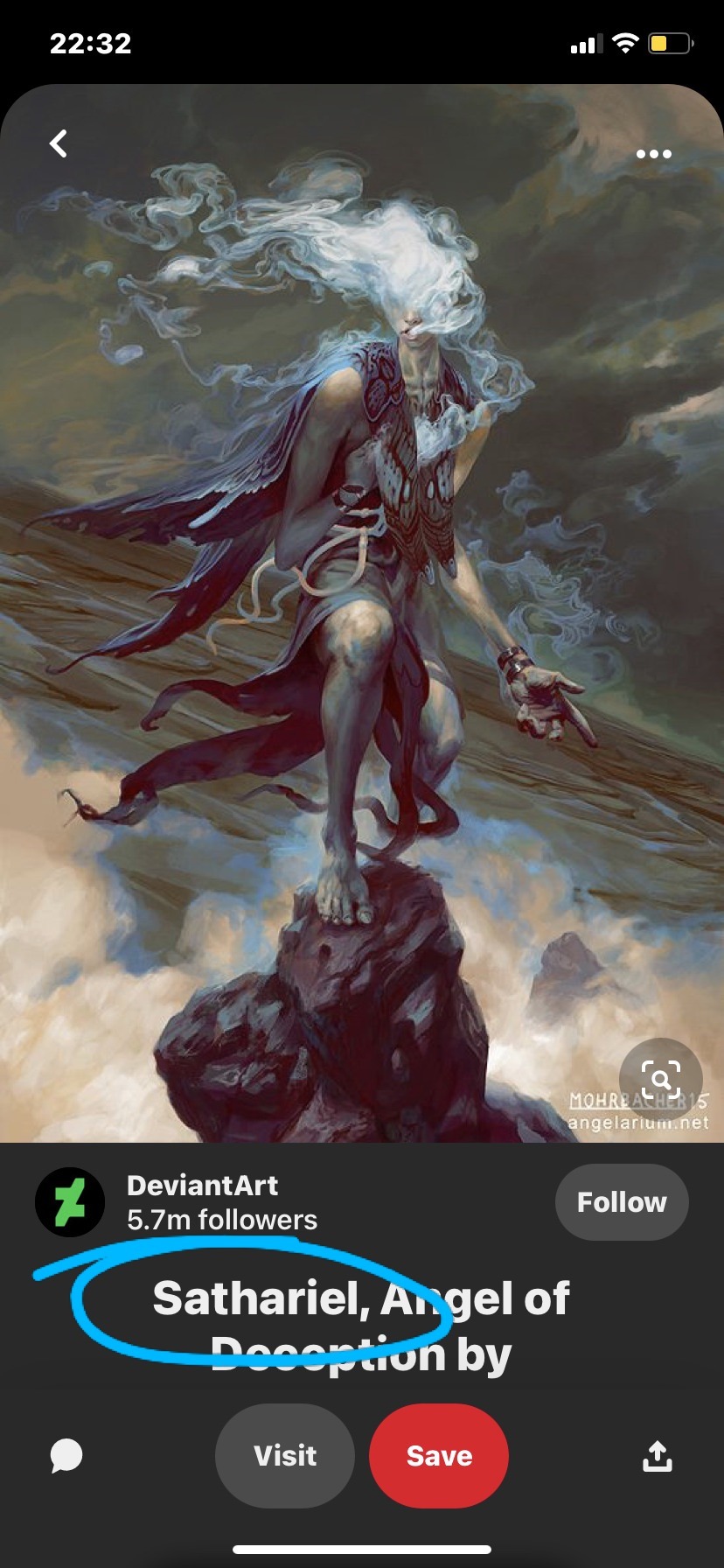
Sathariel (Hebrew סתריאל, Greek: Σαθιήλ) is one of the Qliphoth, corresponding to the Sephirah Binah on the kabbalistic Tree of life. It represents the Concealment of God, which hides the face of Mercy. The form of the demons attached to this Qliphah are of black veiled heads with horns, with hideous eyes seen through the veil, followed by evil centaurs.
'veiled heads with horns'
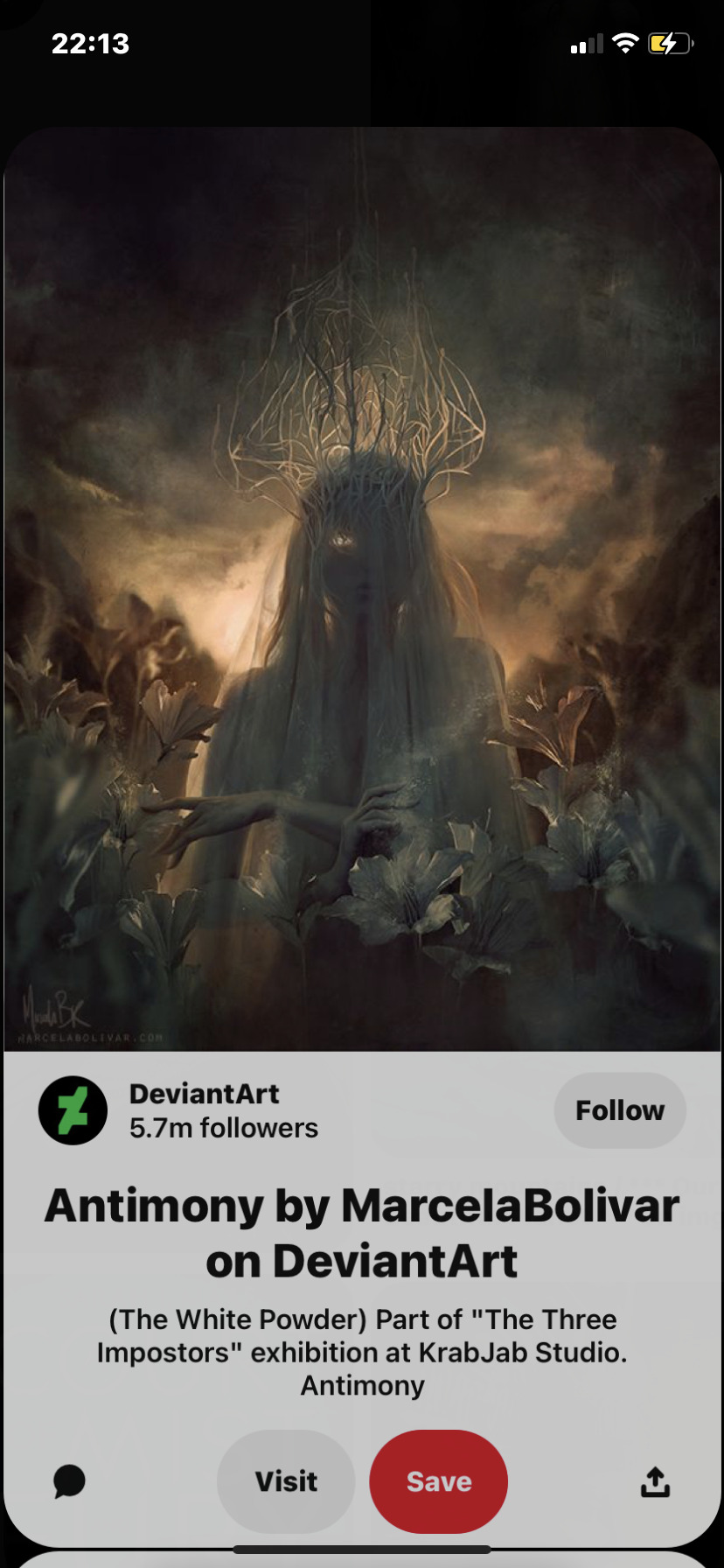
The Qliphoth are the shadow of the Sephirot, the chaotic force that exists when the Sephirah is unbalanced. Binah is the Sephirah that gives birth to form, the great mother of the cosmos, the eternal womb. Through her, the spiritual energy of Keter and Chokmah are woven into the matrix that eventually becomes matter.
In Jewish Kabbalistic cosmology of Isaac Luria, the qlippot are metaphorical "shells" surrounding holiness. They are spiritual obstacles receiving their existence from God only in an external, rather than internal manner.
Quiphoth (shadow of sephriot) = Shadowsinger
"shells" surrounding holiness = The shadows protected Azriel
They emerge in the descending seder hishtalshelus (Chain of Being) through Tzimtzum (contraction of the Divine Ohr), as part of the purpose of Creation.
Sathariel had black feathers on his wings and his body was shrouded in darkness.
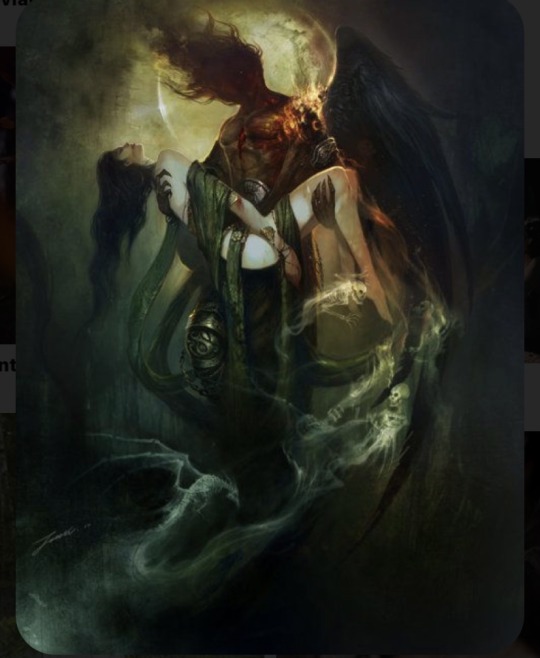
Honestly idk where tf im going with this 😩😩
I've put in far too much effort to delete it so i apologise if you've gotten all this way to be disappointed but
Conclusion:
Mor =/≠ Three fates
Gwyn = Heritage is sus? could be related to some interesting people
Azriel = Sathariel ?
If anyone has ideas to add pleaseeee tell me lol
i'll probably update this when i can be bothered
(FYI i love Gwyn and i'm not saying she's a siren or luring anyone but you've got to admit her grandmother is a sus lmao, especially with half the shit on SJM's pinterest.)
#i have not slept#this makes zero sense#acotar#azriel#azriel x gwyn#gwynriel#gwyneth berdara#azriel berdara#morrigan#acotar theory#acotar 6#acowaf#acomaf#acofas#acosf#a court of frost and starlight#a court of mist and fury#a court of silver flames#a court of wings and ruin#a court of thorns and roses
83 notes
·
View notes
Text
Response to the Moral Question of the MugenxFuu Romance
This is a full response to an anonymous ask I received:
“Can I ask why you ship fuugen? Isn’t Fuu a minor and Mugen is 19.”
This is a rather...complex and loaded question. There’s multiple things to address but I’ll start simple and work up from there. I will first go into my personal feelings on why I ship the pairing, evidence, and then the more complicated concept of the character’s ages both in reality, as well as in the fictional anime. Hopefully it will alleviate some distress on the issue. If it doesn’t, and you consider the age gap morally unacceptable, then it might unfortunately serve to make Mugen out to be a morally questionable character, implied romance aside.
The Simple Question: Why do I ship it?
I ship Mugen x Fuu because it’s implied canon by the creators.
I believe strongly, and have found and provided plenty of evidence in my numerous other posts that support my belief, that Mugen and Fuu were written to have romantic feelings for one another. These feelings were never addressed, acted upon, nor explicitly spelled out for viewers. But the subtle implications of their unsaid feelings added up, episode by episode. The interviews of Shinichiro Watanabe, Ayako Kawasumi and Ginpei Sato only solidify my interpretations and findings.
The actual anime aside, here are the links to my posts concerning the interviews, if you are interested.
-Shinichiro Watanabe about Mugen’s Character.
-Ayako Kawasumi and Ginpei Sato about Fuu’s Feelings for Mugen in the Roman Album.
I adore the entire cast of Samurai Champloo, as much as by themselves as I do as a trio. I love Jin just as much as Mugen and Fuu. However, I do not see any implication of Jin having romantic feelings with either of them. His romance is canonically with Shino and his role for Fuu feels more brotherly and fatherly to me.
Personally, I am not a “crack shipper”. I am not someone who typically likes two characters and pairs them off together for my own amusement. I have nothing against crack pairings, nor their shippers, but it is not my taste. I enjoy romances that have some type of evidence or backing behind it. So it is not as if I simply ship Mugen and Fuu because I like Mugen more than Jin.
If hypothetically, all the things that happened with Mugen and Fuu happened with Jin and Fuu—if Jin saved her constantly, if Jin and Fuu had strange, intimate moments like the wrist grab scene, if Fuu jumped in the way to save Jin’s life, if Fuu cried for Jin seven times, if Fuu’s voice brought Jin back from death, if Jin gave up his sword for Fuu—well, I would not be a fan of the Mugen and Fuu ship. I’d be a fan of Jin and Fuu.
But that is simply not how the anime was written.
On that same note of liking an implied romance, I am not as interested in blatant romance stories either. Implied, subtle romance is so interesting because it leaves enough clues that one has to find themselves, and then you are able to make your own interpretations and “what if” scenarios surrounding it. This is why I enjoy the story types of, say, the Souls video game series and its related titles. (Demon’s Souls, Dark Souls, Bloodborne, Sekiro). The story lines have to be figured out, and while there is evidence and clues dropped all over, nothing is ever specifically stated. But even so, we can come to solid conclusions that are difficult to disprove, but also never fully confirmed.
Samurai Champloo spells out very little for viewers. Example: Never does the anime state what island Mugen is from. We only know it’s in the Ryukyus. But based on historical evidence, and also symbolism in the show (the paantu and the trees in his flashback) we can assume it’s Tarama-shima or another island in Miyako.
Never do Mugen and Fuu state they have feelings for one another, but it’s in subtle dialogue, numerous times. Most blatant however, is when Sara tells Mugen “It’s as if you’ve never been loved by anyone.” and then Fuu proves her wrong by saving his life by throwing her own in the way, only seconds later.
Their actions fascinate me. Both Mugen and Fuu demonstrate self sacrificial behavior for each other, and show how much they care with actions rather than words. Most of all, I enjoy the romantic trope of “love leads to a character’s redemption.” Mugen’s feelings for Fuu is what redeems him from the sins of his past, and saves him from a life without meaning and only pain, anger and hatred. These aspects of his dark character are highlighted both by the dialogue of Mukuro in Episode 13 and Sara in Episode 21. Fuu being his redemption is also symbolized in her saving him on three separate occasions. The last incident, when she calls him back from death and the Paantu taking him away, is the most symbolic of his “redemption”.
Samurai Champloo is a direct response to the cynicism of Watanabe’s previous work, Cowboy Bebop. Where revenge and the past consumes Spike, ruining his future and love, Mugen is redeemed by love and is able to face his past and press on.
Here is a fantastic article about the concept of Mugen’s love for Fuu being his redemption and also being a direct response to Cowboy Bebop.
All of this aside, because of the second comment, I’m assuming that this isn’t necessarily what you were asking.
“Isn’t Fuu a minor and Mugen is 19?”
I’m guessing you’re implying that either the romantic pairing is impossible due to their age gap, or it’s morally wrong.
I was conflicted how to answer this, at first. I know this can be a triggering topic. So I decided on providing several explanations. I hope at least one answers the question properly, or at least sheds some light on the issue.
Either it will justify why there is nothing morally reprehensible about the Mugen x Fuu romance, or, it will unfortunately show that Mugen is morally questionable, depending on how the evidence is taken.
First, at 15, Fuu is not a minor in her time period. Second, Mugen is either 19 or 20 depending on the source.
Samurai Champloo is not set in one specific year of history, as the anime is not only anachronistic, it historically takes place in multiple years that could not coincide. In essence, Samurai Champloo is not one year, but “a chanpuru of one whole era.” This era is the Edo/Tokugawa era, which includes the years of 1603-1868.
In the Tokugawa Era, Fuu is considered an adult. She is a young adult, yes, but in the eyes of everyone, she is an adult. This is both historically accurate, and is also demonstrated numerous times in the anime. Fuu’s sexualization and her being seen in a romantic way is never frowned upon by any of the characters in the entire series.
Brief disclaimer: Nowhere in my love of the Fuugen pairing or fan interpretations of the characters’ futures, do I see any sort of sexual relationship between Mugen and Fuu developing when she is 15. After they part ways, is where I like to make my fan conclusions on them meeting again when she’s older.
I also want to clarify here and now, that I’m not a supporter of a 15 year old entering a romantic relationship of any kind, let alone a sexual one in real life. I think that teens should work on themselves and not get swept away by romance and sexuality, especially frivolously. It’s irresponsible and dangerous. But, it’s also unrealistic to believe all young people will never fall in love, whether it’s fake or real. If there happened to be a man who was 5 years older than a girl and the two did develop feelings for each other, I believe nothing should be pursued between them until they are both of age.
Adulthood in the Tokugawa Era
I want to first talk about the concept of Fuu being a minor. In short, she is not a minor in her time period.
To begin with reality first, the life expectancy hundreds of years ago was much lower than now. In Japan now, the average life expectancy is in the 80s. But hundreds of years ago, it was estimated to be about 50. Women in particular had the complication of fatality from childbirth. Led makeup, childbirth, and also STDs were a huge threat for courtesans of the time period as well. Many women died in their twenties.
As for the concept of ”adulthood”, the adult age of 18 only started in the Meiji Restoration (late 1800s- early 1900s) when Japan contacted the west and emulated its practices. The age of 18 being an adult nowadays is largely based on the setup of the education system. Whether 18 is too young or too old is a matter up for debate and varies country to country.
Specifically, in the Tokugawa Era, the age of adulthood was considered when one entered puberty. This was generally 15 for a male and 12 for a female.
Here is a link to the full article on the topic of the shifting coming of age, if you are interested.
In the case of aristocratic children, such as boys raised as samurai, the Genpuku ceremony that transitioned children to adults varied in age. During the early Tokugawa era, it was 15-17, while later into the Tokugawa era, during less civil unrest, the age dropped to as low as 13. At this age, these young men could then marry and were likely pressured to do so. Marriages in the Tokugawa Era were very different than nowadays as well. Many nobles and royalty had their daughters married off at young ages such as 8 years old.Though, the sexual nature of these relationships did not develop until the girl was likely of child bearing age, which was in the teens.
Taking the historical 12 year old age into account, Fuu being 15, is then already three years into adulthood.
Fuu’s Depiction as a Woman in the Anime
In regards to Fuu’s maturity, she has no guardian, nor caretaker, which shows she is an independent adult making her own decisions. Yes, Mugen and Jin are her bodyguards, but they are not her legal guardians, because she does not need one. It is her who commands them and leads them. After they part ways, she is fifteen years old (perhaps a year older based on the time span of the anime) traveling the country alone.
She was forced to grow up very fast. Not only is she an orphan, but Fuu’s resourcefulness allows her to survive on her own. She tricks two complete strangers to escort her across Japan. But Fuu is fully functional as an adult, arguably more than Mugen or Jin in some ways. She works, fishes, cooks, sews, tends to wounds etc. Fuu is by no means innocent to mature situations either. She’s seen Mugen and Jin kill numerous people in front of her, which is traumatizing in itself.
In regards to Fuu’s sexualization,on separate occasions, there are bath scenes in the anime, showing Fuu partially nude. There are also scenes of her undressing. Morally correct or not, it is clear she was sexualized like many young anime females.
Aside from that, here are examples of male characters viewing Fuu as an adult woman, romantically or sexually.
Episode 3 and 4: Fuu is thrown in a brothel. While the legality of her being forced against her will just for the sake of paying off a debt is somewhat in question, the fact that she is 15 in a brothel is not. Brothels were not an undercover organization. It was completely legal in Tokugawa Japan, and Fuu being 15 as a courtesan was not illegal. When an ugly rodent man buys her, it’s served as comedy.
Episode 5: Fuu becomes a ukiyo-e model, the backwards beauty, for Moronobu Hishikawa, who was a real historical figure. This grown man, probably around Jin and Mugen’s age or maybe older, also is not considered a creep for his attraction to her. In fact, it’s not even considered wrong that he paints a nude picture of a 15 year old. Again, because she’s deemed a woman in this time period.
Episode 8: Nagamitsu, who is leagues older than Mugen and Jin, asks Fuu to become the “harem of his heart”. He is attracted to her, sees her as a younger version of his wife when he first met her, and even asks her on a date, to which she accepts. This entire interaction is played off as comedy, and not that he’s some creepy grown man attracted to a minor. More like, he’s a bumbling buffoon. His two sidekicks, the beatboxer and Ogura do not intervene, nor make a comment that it’s wrong he is interested in a 15 year old when he’s in thirties or forties. Because quite simply, in this time period, it’s not wrong.
Episode 16: Okuru tells Fuu that “a woman with a healthy appetite is a good woman” when she is devouring fish.
If you stand firm that it is still morally wrong and all these characters were creeps for being interested or saying these words to a 15 year old, that is fine. If you think it is morally wrong to ship Mugen and Fuu because of the age gap, and refuse to believe that the two are an implied romance, that is fine too. I can’t convince everyone.
However, I will make the counter argument then, that liking Mugen as a character means liking a morally questionable character. Romance and feelings aside, the reason for this is simply how he treats and talks to Fuu.
Mugen’s Questionable Dialogue to Fuu
If shipping them is wrong, then what Mugen directly says and does to Fuu is just as wrong. In my opinion, it makes it weirder if he doesn’t develop feelings for her.
Episode 2: In the original Japanese dub, Mugen tells an unconscious, intoxicated Fuu that he’s going to rape her. “Okasu kureru” is the dialogue.
The English changes this to “Let’s strip her and dump her.”
Episode 11: When Fuu asks why Jin needs to go see a woman when she’s around, Mugen then responds “Because you’re flat chested”, not to be confused with “You’re a child.” When she says her kimono makes her look slender, Mugen calls her a liar and then says “Show me.” He asks Fuu to undress for him and show him her breasts...
Episode 20: Mugen stands up naked for Fuu in the hot spring even though she’s clearly flustered. Exposing oneself to a minor is an offense in the modern era. But he doesn’t stop there. He berates her, and then peeks his head out to look at her naked too.
All of these examples are meant as fluff and comedy too, no matter how offensive they can be. It also implies his attraction, interest and his consideration that she is indeed a woman. This is then furthered in his dialogue with Jin.
Episode 12: When they read Fuu’s diary, Mugen asks the odd question to Jin. “Man to man, what do you think of her?” This “man to man”, implies Mugen wants to know how Jin feels about Fuu as a woman.
As for a debatable canon example, I have the need to bring up the Samurai Champloo: Sidetracked video game on PS2. In Japanese, it is entirely voiced by the same cast as the anime: Kazuya Nakai, Ayako Kawasumi and Ginpei Sato. In English, Mugen is not Steve Blum, but Fuu and Jin are the same voice actors as the anime: Kari Whelgren and Kirk Thornton.
In it, Mugen develops an attraction to a girl who looks nearly identical to Fuu: brown hair in a ponytail, big brown eyes, pink kimono, three hairpin beads. The kicker is her name is Yuu. The even bigger kicker is that she is younger than Fuu.
Here are the links to the scenes. Japanese audio is much better, as a warning.
Link to English, Fuu catches them alone and tells Jin “I had no idea Mugen was a cradle robber!”
Link to Japanese: Fuu calls Mugen a “lolicon”.
When the girl asks “Do you like me? You can lie if you want.” he tells her:
Link to Japanese: “Suki da. Uso jane.”
Link to English: “I like you. I ain’t lyin’.”
And the two share a kiss, before she dies. Worth mentioning, Fuu also admits to being jealous about all this and a fortune teller tells Fuu that this is her “heart talking.”
While debatable canon, the video game still highlights this concept that Mugen will even like a girl younger than Fuu (anywhere from 12-14), so long as she resembles Fuu.
If we pretend for a moment that Fuu is indeed a minor in her time period, then that makes Mugen’s actions and comments out to be even worse. Not only is he a pervert, but he’s then a pervert flirting and making sexual comments about a ”minor”.
Underaged Girls and Age Gaps in Other Japanese Romances
If you still believe that there is something morally wrong, regardless of the time period it takes place in, I have more modern examples in media.
Modern Japanese shoujo manga and anime (shoujo being a genre directed at teenage girls) is rife with romance stories of older guys with younger girls. It’s not frowned upon in Japan, and even for its readers in the west.
I will give you some major examples I can think of, off the top of my head.
Inuyasha: Inuyasha and Kagome. Inuyasha is over 150 years old (not counting the other 50 years he was comatose). Yes, he ages slower as a half demon, but that is still 150 years of experience in life. Kagome meanwhile, is 15 years old and does not come from the Sengoku era. She’s from the modern era. If one wants to argue that Inuyasha doesn't count because every decade for him is one year, meaning he’s supposed to be “15 in human years”, then there is the matter of Miroku. Miroku is 18 years old, and fondles not only Kagome who is 15, but Sango who is 16. And he and Sango later become a romance.
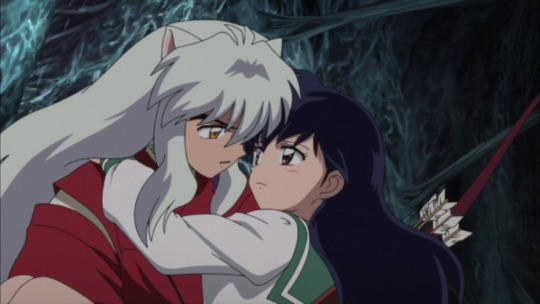
Shugo Chara: Ikuto and Amu have an age gap of 17 and 12. While there is a love triangle element, it is debatable that Ikuto is more her true love interest in the manga. This takes place in the modern era.
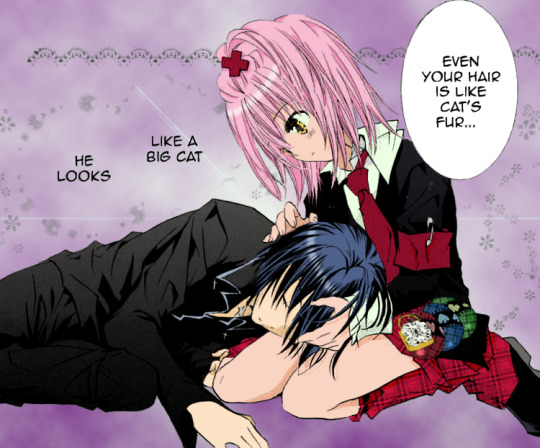
Dengeki Daisy: Kurosaki and Teru have an age gap of 24 and 16. This also takes place in the modern era.
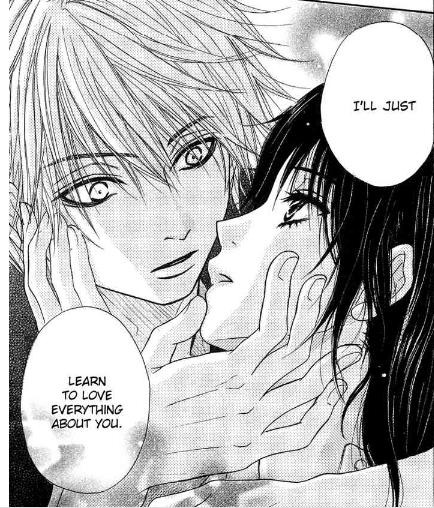
Incidentally, all of these aforementioned romances share some parallels to Mugen and Fuu in some way. Whether the guy is argumentative with the girl, a homeless wanderer, antagonist by nature, teasing about her lack of a figure, a bodyguard/protector role etc.
These are just a few of the more pure Shoujo examples directed at young girls.This does not include age gaps between characters, or underaged girls in anime meant for men or adults in general. They can get far more morally questionable, in my honest opinion. Mugen and Fuu barely scratches a surface. There is clearly a cultural gap between Asia and the West and the concept of age gaps, regardless of one’s personal moral stance on the subject.
Mugen and Fuu’s Actual Age Gap and Maturity
In the Tokugawa Era, their age gap of 4 to 5 years is incredibly small. Even nowadays, that age gap is very small, if Fuu was a legal adult in modern times.
Tsuru-himegimi, the real daughter of Shogun Tsunayoshi was 8 years old when she was married to her husband Tsunanori of Kii, who was 12 years her senior.
As for the anime’s depiction of them, there was never a sense of “Fuu is child. Mugen is a man”. It always felt like the two were in a similar age bracket.
I must ask the question, if Fuu or Mugen’s ages was never revealed, would it change the context of the story at all? If Fuu was older, would it change it? Personally, I don’t think so. In this case, because she is both physically developed and also deemed a woman in the anime and historically, it changes nothing.
Their interactions, their bickering, their attitudes, and the way Mugen yells at her, and the way Fuu reprimands him, it always felt like they were similar. They both exhibited many immature, innocent qualities, as well as adult qualities. It was Jin who had a more mature demeanor, being the calm, responsible one, who would rather not intervene with their nonsense. This is another reason why I see Jin as a father figure to Fuu: a representation of the samurai who smells of sunflowers that she did not have growing up.
These images here show their similarities in behavior quite well. And there are many more examples.
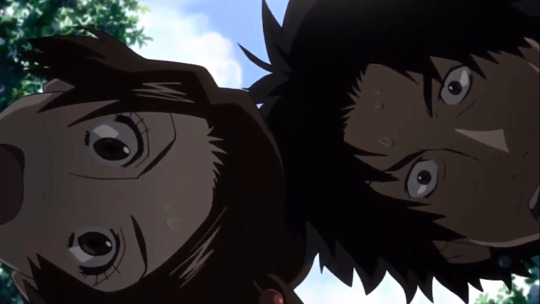

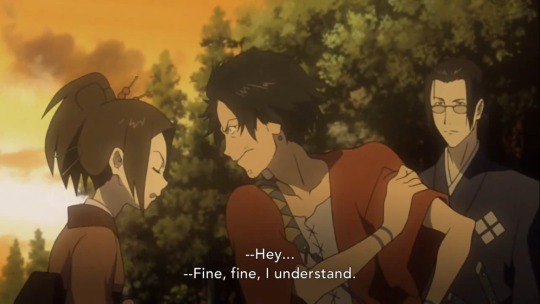

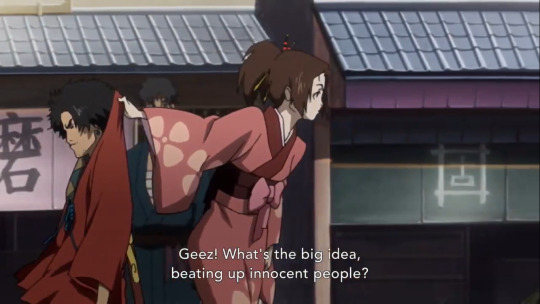

Conclusion
A good, well developed character is not a perfect one. There is no denying Mugen is flawed, morally questionable and sometimes straight out an antagonist. He steals, he kills, he was an ex-pirate who likely raided and pillaged… Realistically, he would have no qualms about being attracted or developing feelings for a woman who is 4 or 5 years his junior, let alone the other crazy stuff he’s done. Especially when, in their time period, there is nothing wrong about it at all.
Regardless if his morality is in question or not, what makes the implied romance so interesting is the fact that he didn’t act upon anything sexually with Fuu. His actions towards her were selfless, and Mugen developed greatly by the end. But because of his actions and words,and jealousy, it does not come off as simply a sibling or familial relationship that the two have. This differs from how Jin and Fuu interact.
Most importantly, Fuu serves as the catalyst for Mugen’s growth and redemption of his sins. Unlike Jin, Mugen saves Fuu time and and time again, making him her hero, despite being seemingly an ex-criminal that only works in self interest. Jin did not require this change, as he was always an honorable samurai from the start.
Both men found purpose for different reasons.
Mugen needed love.
Jin needed duty.
I think that covers everything. Well, unless your question is simply why do I ship them when the characters are young and I’m older than them.
As of the time of making this post, I am a 23 years old woman. The first time I ever set eyes on the anime, I was 8 or 9 years old. As a kid, I had my first innocent, childlike suspicion of a romance between them when Mugen first went to save Fuu from the “bad place”, being the brothel in episode 4 without any reason to, while Jin didn’t. Also, he saved her in Ep 1 and 2 and Jin didn’t.
The first time I got to watch the whole anime, I was 13 and saw the full story play out. And at that point, I was more convinced. Over the years, I rewatched, looked into a lot of the history and symbolism used in the anime, analyzed the episodes, and I became more convinced. I shipped it when I was Fuu’s age of 15. I shipped it when I was Mugen’s age of 19/20. And, I will likely continue to cherish the beautiful story of Samurai Champloo and the implied subtle romance of Mugen and Fuu for years to come.
Perhaps it is a reminder of the purity and innocent nature of love for me. These two did more for each other, cared more for each other, and were more entertaining with each other than so many cliche, blatant romance stories.
#samurai champloo#fuugen#mugen and fuu#Mugen Samurai Champloo#fuu samurai champloo#shinichiro watanabe
63 notes
·
View notes
Text
Reiner & Mikasa: A Retrospective Pt.2
“The Shield of Marley & The Blade of Paradis”
Why ReiKasa is a (BR)OTP ship that’s worth more than a fleeting glance
[*caution: a continuation of a long reflective post with the sole intention to share a fan’s perspective through available representation through manga, anime, exhibition & etc. This post is not to convince nor argue where is its place in canon, but only to explore the vast possibilities of these two amazing characters that I love. In the end, if the series ends with Mikasa alive & ending by herself or with X character, then it means Isayama believes that X character is the one she’ll find that eventual happiness with and I’m all for that. Same goes with Reiner :)] Special thanks to @berumika for sharing some of the additional points that are included in this post. Years down the line after SnK ended, I’d love to have a post I can revisit of these two amazing characters & the possibilities that could have been from time to time. I’m having absolute fun in observing how much both of these characters have grown since the series debuted in 2010.
Pt. 1 available here. Warning: Image heavy, potential spoilers.
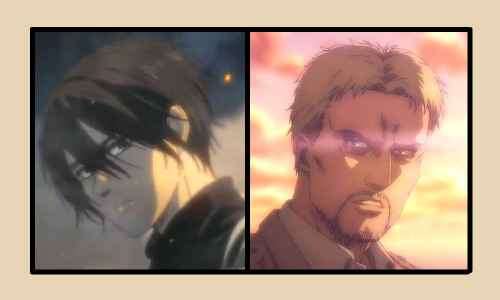
When I first got to know SnK/AoT, it was through the anime first before manga. Bad idea for me. My initial perspectives of Mikasa & Reiner were skewed and that was later rectified as I navigated the original source directly. Eren is the first protagonist that was introduced by the series creator but I was drawn to Mikasa & Reiner when I started the manga after Season 1 ended.
Trainees
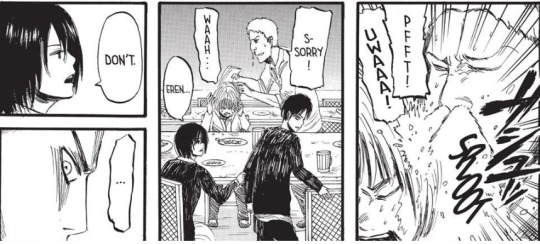
These top two trainees of the 104th batch are closely matched to each other in ranking. We don’t see them interact directly in the anime, but in the early panels of the manga, Reiner could be seen sitting down with Eren, Mikasa & Armin during mealtimes.
Sure, Mikasa can be expected to not converse with Reiner directly, but if her two childhood friends have their good friend sitting together for meals, at the very least we can expect them to have some brownie points in socialization.

Apart from being total gorgeous hotties, they’re both physically strong people, with Reiner always being second to Mikasa in terms of brute strength. Total muscle pairing and I could see them being at par with each other during physical drills. Reiner & Mikasa could go all out, even beyond 100% and the other would be physically capable to take/receive the force. Shadis would’ve tasked them to lead the physical trainings from time to time. They have been sparring partners, evident from the moment Mikasa threw Reiner across the field into Eren who’s sparring with Annie. Their fitness regime would be in-sync with each other. I could see them having mad respect for each other and secretly admire the other person’s prowess and skill.
Connection through Eren
As highlighted primarily in Pt.1, Eren has been shown to look up or aspire to be high achievers like Reiner and Mikasa both. He wanted to be as strong as the two of them. The odds of the very same people he look up to, as the two individuals who would be able to stop him, I would suspect as very high at this point.
When they were younger, Reiner has always been the one that’s pulled Eren up when he’s down, nearly giving up & at the lowest points of his life. He was also the one who convinced Eren to ‘keep on moving forward’, which we’ll learn later was one of the most ironic moments that Reiner recalled as he feels responsible for everything that begun, which also pushed his guilt inside him to his near-suicide attempt.
Survey Corps
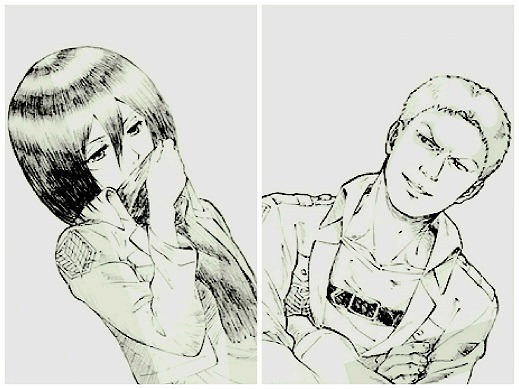
Reveal on Wall Rose
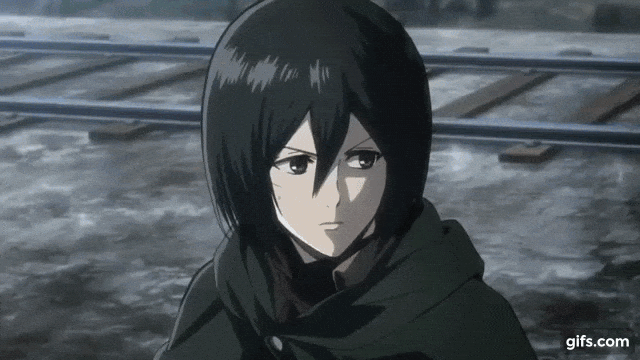
Mikasa, was one of the few junior SC members who were called in for the secret meeting with the unit’s top brass the night before the reveal. She was made aware of Reiner & Bertolt’s possible identity as the enemy after she assisted with apprehending Annie in Wall Sina. While Reiner was talking to Eren, Mikasa could be seen being highly agitated, hands shaking as she waited with unease breath for Reiner & Bertolt to make their move.
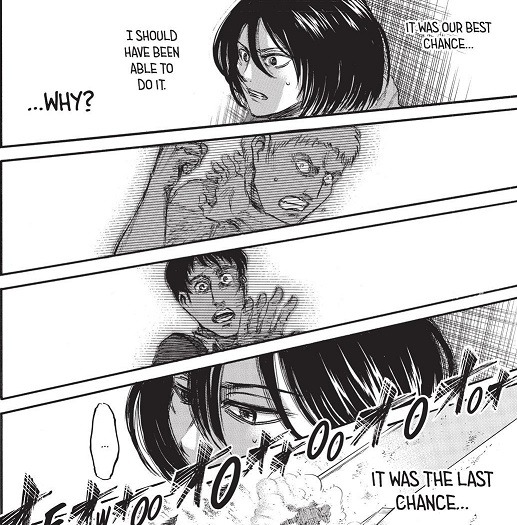
She was later seen questioning her hesitance on delivering the killing blow or at least enough to incapacitate them. Mikasa called Reiner & Bertolt “the plague of humanity” in anger and absolute disappointment. They were still her friends that she knew for three years & it had been difficult for her to kill them.
Thunder Spears Training

Mikasa could be seen reflecting in a combination of unease, sadness & regret as she recalled back the moment she was unable to break Reiner’s armor with her blades.
Return to Shinganshina
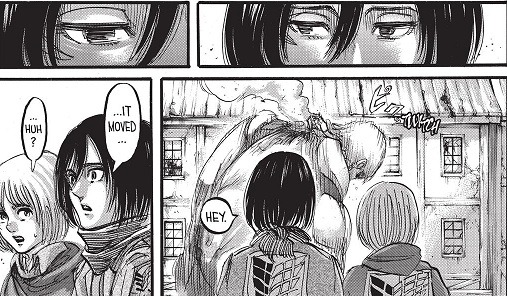
Mikasa was the one who crippled the Armored’s legs. She wasn’t as emotional as Connie, Jean & Sasha but there was a deep, painful rumination on her part the moment they assumed that Reiner was dead dead. She was also the one who noticed the sudden move from Reiner’s Armored Titan. In the anime, she could be seen angry & frustrated at Reiner’s refusal to confess that she pulled too hard on the bandage in her hands while she was helping Jean with his injuries.
Time-Skip (Current)
Reiner’s reminiscence & nightmares
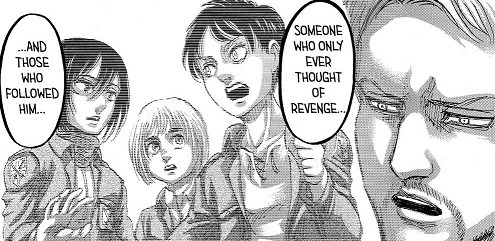
Reiner’s reminiscence of Mikasa was indirect, but he highlighted her (and Armin’s) fierce, unwavering loyalty towards Eren. He had recurring nightmares of her & Levi that are the symptoms of his PTSD. The anime specifically used her shot to highlight the last image of her that he saw: anger.

Assault in Liberio

You could see the existing disappointment on her face when Reiner’s partially transformed Titan appeared, having to cross paths again in such a way after four years. She could’ve intervened the way she did with Galliard’s Jaw but she didn’t. Eren said Reiner’s out of any energy left to retaliate and Mikasa didn’t disagree. At this point, Mikasa is already affected by Eren’s actions in murdering the women & children inside the building that he shifted in and the destruction they all left behind.
Connection through Gabi
Reiner’s young cousin reminded Armin & Mikasa of a young Eren. The difference is that, Gabi had an early opportunity to be saved through the compassion showed by Mikasa and Sasha’s beloved family. The very same people who had every right to be sad, grieving and taking out their anger on the child who gunned down their beloved friend & daughter.

Mikasa doesn’t verbally express her emotions but it can be shown through her body language & facial expressions. I love seeing the tender way she pressed Gabi’s head onto her shoulder as protection and a symbolism of safety. It was a bit sad that this ‘bond’ was short-lived but what an amazing connection it would’ve been if Mikasa & Gabi had been given more space to develop their bond in canon.
Concern for Reiner & Annie
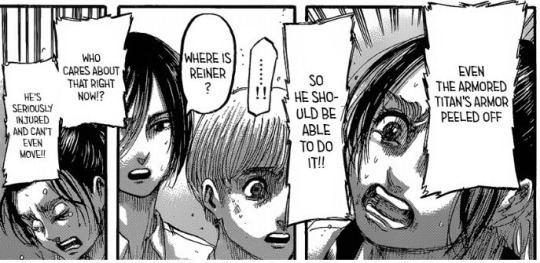
Usually when Mikasa verbally expresses something, it is usually important/significant to her. In ch.124, she could be seen asking Gabi about Reiner’s location. Why? It’s because she is concerned for Reiner’s safety. If his Armors were undone, he was vulnerable and with pure Titans and the Colossal Titans walking around, he would be in danger.
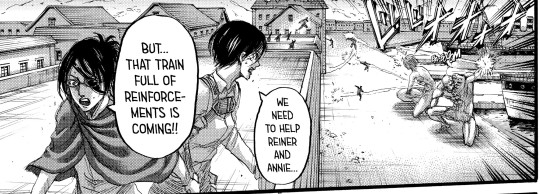
“We need to help Reiner & Annie.” She was heavily concerned with Reiner and Annie’s lives at the docks. But this moment is more important for Connie as a callback to the moment when Annie & Reiner both had saved Connie when they were trainees.
Adjacent Manga/Official Art Paneling(s)
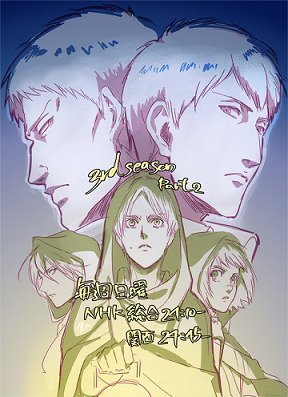
In the current final arc of the manga, (several panels have been highlighted in Pt.1) it’s quite interesting to note that Mikasa & Reiner’s characters/panelings have been drawn adjacent to each other. I could also see the way Armin, Reiner & Mikasa (ARM) are getting primary focus by Isayama in this final arc.

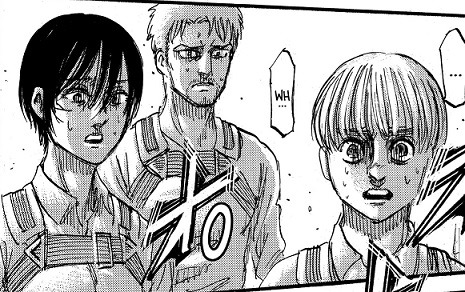



Others (Misc./Semi-canon)
Cool-faced Cookie (Attack on Titan Game)


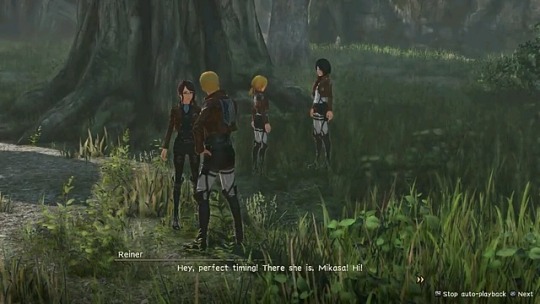
When Reiner suggested the player to do a melee practice with two other sparring partners, he immediately spotted Mikasa & Historia. It’s very interesting to note that Reiner’s nickname for Mikasa is “Cool-faced cookie” as he hinted the player to ask Mikasa for an impromptu practice.
The blink and miss furtive glance(s)

In Lost Girls OVA’s ED by WIT, a screenshot of the primary 104th walking together could be seen. Mikasa could be seen sneaking a glance at Reiner.
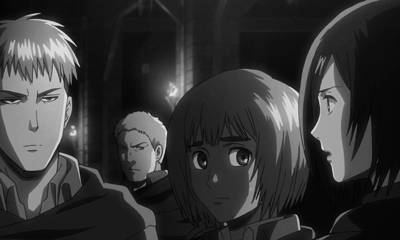
In a scene during the fresh SC recruits discussing intensely about Eren’s role as humanity’s hope, Reiner could be seen glancing silently with concern for Mikasa, as Jean questions her vouch of confidence in Eren’s abilities.


In Snk OVA#3, Mikasa is grouped with Reiner for the excursion and they could be seen having good teamwork together. When Mikasa’s ‘sixth senses’ are triggered due to Eren being in danger, Reiner could be seen looking at her direction immediately as if sensing her distress.
Characteristics & Zodiac Signs
Amazing/Compassionate with children

Known as the Shield of Marley, Reiner’s a caring keeper, a natural leader and a provider who’s naturally amazing with children. Everyone looks up to him. Would’ve made a good family man if the circumstances were different. Based on his characteristics & physical attribute, he reminds me of Mikasa’s father below, no matter how short-lived he was. I could see her admiring that side of him even if it wasn’t mentioned directly. They are both loving, selfless, protective towards their child/ward.

Mikasa, true to her name, an Ackerman, a genetically-enhanced super soldier/warrior of Paradis that wields their blades with the highest efficiency. Though she might not seem as natural with children, did come from a healthy & loving upbringing with her parents for nine years. Her real persona as a child pre-awakening is a curious, thoughtful and actually a warm-hearted girl. Post-awakening characteristics could also be contributed from the traumas imposed by the murder of her parents, the fall of Wall Maria, the death of Carla & having to shoulder the immediate responsibility as Eren’s new ‘guardian’/caregiver/problem-solver/mess-cleaner.
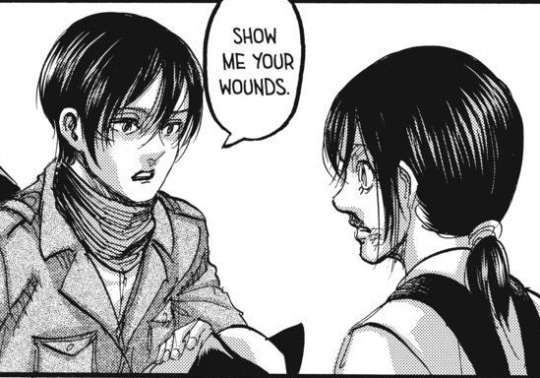
She shown her compassion towards Gabi, which in turn had proved to the little girl how there are good-hearted, forgiving people in the Island. Mikasa could be observed as being heavily concerned with Falco as she questioned Jean about the young boy. One could see the anger on her face when she saw Connie took off and abducted Falco to be fed to his mom. She drew the line in harming children even if they’re trained enemy soldiers.
Aquarius & Leo’s Compatibility
Reiner’s a Leo and Mikasa’s an Aquarius. Their characteristics are too coincidental to their respective astrological signs to be disregarded completely.
He’s an extrovert (Ref: younger!Reiner. Older Reiner too but his PTSD’s and maturity have taken over his more outgoing personality) that compliments her introvert personality yet they both have their inner demons to deal with and could somehow understand that about each other. He’s a ray of sunshine that could enlighten her melancholic personality. Yet their dominant personalities, although might be clashing at first, eventually would lead them to respect the other’s perspective. This would ring true when they were younger. Currently they have grown older, wiser and more understanding of the other.
At the current Final Arc, this has been highlighted in Part 1, recent chapters have shown older Reiner and Mikasa’s unspoken respect and understanding for each other. The current Reiner’s natural leadership as a born Leo is very apparent. Reiner was being very mindful of her feelings as Eren is a very sensitive subject & Mikasa took in Reiner’s words with serious consideration.
It would be great to see more of their combined synergy as Reiner & Mikasa’s teamwork could be seen once again in ch.135. Aquarius & Leo would take turns to take a back seat while letting the other leads.
They are actually very physically and sensually compatible with each other & could potentially be an unstoppable force if they were to fight for the same side. At the moment, I’m hoping to see this potentially deadly combination once again in ch.136 onwards. They could’ve overtaken Eren’s Founding Form is it wasn’t for OG!Ymir’s one-sided overkill powers. To the real God who created the parasite worm, please take powers away frpm this uncontrollable grandma in a little girl’s body.
More of Mikasa’s Aquarius & Reiner’s Leo Compatibility Meter with description below:
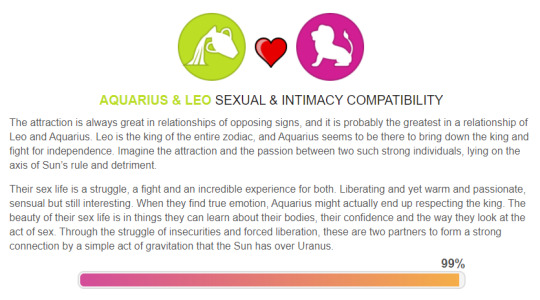
Since this is SnK and not Berserk/Tokyo Ghoul/insert other josei manga titles, no one’s having sex directly haha In an ideal world, Reiner & Mikasa’s physical attractions for each other will almost be off the charts. “When they find true emotion, Aquarius might actually end up respecting the king”. In current arc, this can be observed. She respects Reiner & his words.
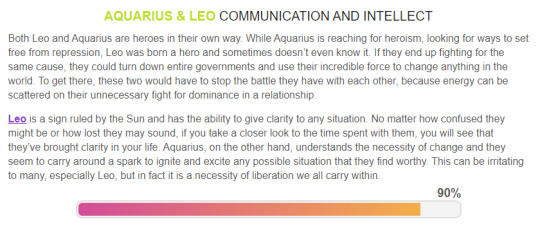
The above describes both Mikasa and Reiner respectively. Mikasa does not reach for heroism directly but it can be seen indirectly from the way she had inspired a child Louise through her bravery, protecting Gabi and rescuing/protecting the Azumabito Service crew from the Jeagerists. Reiner has always been born to be a hero, regardless of the circumstances of his conception or birth.
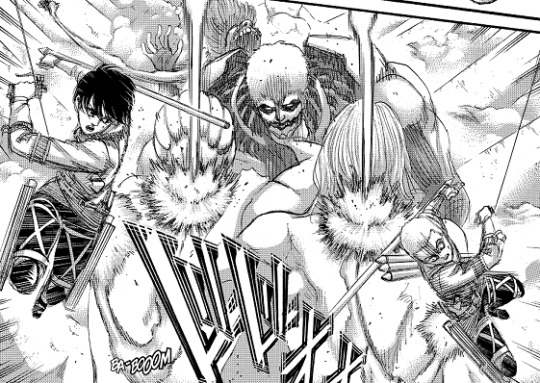
“If they end up fighting for the same cause, they could turn down entire governments and use their incredible force to change anything in the world.”
Even oppressive, destructive supernatural, God-like powers? Ymir & Eren, better be prepared.
“To get there, these two would have to stop the battle they have with each other.” Check and Check.
“Leo -- has the ability to give clarity to any situation.” Ch.133. That was not Reiner projecting. He’s always been Eren’s counterpart. He’s telling the readers that there’s a part of Eren out there that still wants to be stopped since he has surrender his will to Ymir. She took his words into serious consideration and in Paths, voices out to Eren on his sins and burden.
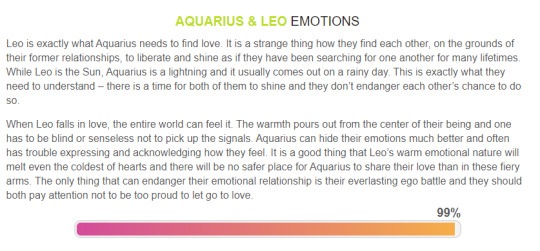
“Leo is exactly what Aquarius needs to find love. -- to liberate and shine as if they have been searching for one another for many lifetimes.” In an ideal world or in my gazillion AUs: Reiner and Mikasa could be soulmates.

This could ring true for the younger Reiner & Mikasa.
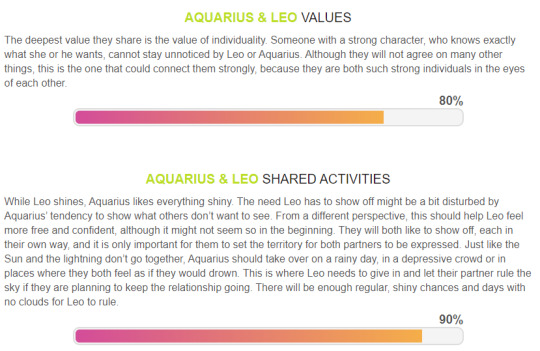
Reiner and Mikasa both are indeed strong, selfless individuals in each other’s eyes. This can be observed in Ch.133 & 135. Reiner feared her but respect her strength & feelings when it relates to Eren nevertheless. Even Reiner was taken aback by Pieck’s ultimatum in blowing the Founder’s neck, although Armin had suggested the same thing the night before.
“Just like the Sun and the lightning don’t go together, Aquarius should take over on a rainy day, in a depressive crowd or in places where they both feel as if they would drown. This is where Leo needs to give in and let their partner rule the sky--” It wasn’t a rainy day or depressive crowd in ch. 135, it was a chaotic shitstorm and they were all not drowning but dying. Period. Our dear Mikasa took charge like a BAMF Queen that she is. She was putting her life on the line to protect the four injured men behind them. She aimed to buy them more time if she could as everyone expected it to be the end. As highlighted in Pt.1, you could see the helplessness on Reiner’s face when he saw Mikasa’s breaking point.

Reference : http://www.astrology-zodiac-signs.com/compatibility/aquarius-leo/
Final Exhibition
The Final Exhibition highlights the Last Stand: the direct final confrontation between The Founding/Attack against The Armored, with Mikasa being in the middle of the confrontation, tipping the scales of the outcome. Before, she assisted Eren against Reiner. Currently, she is working with Reiner to stop Eren.
Trio(s) Parallel
An interesting panel from ch.97:

EMA & RBA have always been lauded as the main trio of their respective sides. We have seen Armin taking over Bertolt’s powers & is potentially promised a future with the girl that Bertolt had feelings for. Recognize the probable pattern?
Guy from trio 1 ate Guy from trio 2′s Titan & is promised a potential future with the girl he cares for/have feelings for/close with from the trio.
Only one between between Eren & Reiner will remain. What if the story begins with Eren but will end with Reiner all along?
SnK HighSchool AU / Breakfast Club X-over
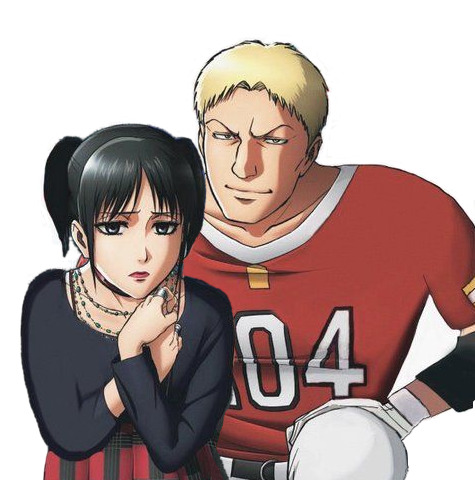
In the movie, the Jock (Quarterback!Reiner) ends up with the Rebel (Goth!Mikasa). He looks past her eccentricity & see her for who she is. This is a fun crossover by Isayama but very interesting to see Armin, Mikasa & Reiner work together to save Eren in the fake previews.

Whether the combined strength and perseverance of the Blade of Paradis & the Shield of Marley be enough to save the world from total annihilation? It remains to be seen very, very soon.
No matter how the series ends, whether both Reiner and Mikasa survive or not, I’ll be looking back in pride upon seeing their journey, growth & dynamics as either individual or together in this beautiful series by Hajime Isayama’s brilliant mind. Because of him, these two characters inspired his readers, myself included, to be brave and fight for what they truly believe in: humanity & its continuation. It has been an incredible ride and I will continue to enjoy writing for this OTP/BROTP, that I’ve fell so deeply in love with and their vast possibilities.
#snk#aot#shingeki no kyojin#attack on titan#進撃の巨人 Attack on Titan#snk meta#snk thoughts#snk opinions#snk spoilers#snk 135#snk 133#snk 134#Retrospective#reiner braun#mikasa ackerman#reiner x mikasa#ReiKasa#character appreciation#ship appreciation
70 notes
·
View notes
Text
Ariadne and why the Mycenaeans can fuck right off
Warning: Includes brief mentions of r*pe, cultural destruction, ancient patriarchy reminding us why no woman would ever time-travel more than 5 years into the past if that and a great deal of spite for male historians/public education history/mythology classes.
Possible side effects may include a sudden intense rage for an ancient society equivalent to the innate rage one has for the Romans burning the library of Alexandria, a distinct hatred for ancient men not being able to let anyone have nice things, and a sudden fascination for Minoa.
Usually, I stick to writing imagines and being happy with that. It’s fun! I love it! But every now and again, in an attempt to escape the crushing forces known as reality and responsibilities I’ll put on a few cutscenes from games I’m:
A) Too lazy to play
B) Too broke to play
C) Too unskilled to play
D) All of the above
because cutscenes are free and why torture yourself with impossible levels when its free on Youtube?*
*In all seriousness please support video games and video game creators, but no shame to those of us who prefer cutscenes to gameplay.
A few weeks ago I added the game Hades made by Supergiant to the list because the cutscenes were bomb and the characters are so much fun! Intricate as all hell! Hella cute too but that’s unrelated! Now my pretty little simp patootie is especially a big fan of Dionysus and his gorgeous design so the cutscenes with him are my favorite.
I’m re-watching his cutscenes a few nights ago for fun as background when he has a certain line about Theseus. Don’t quote me on this since my memory is foggy at best but roughly it was:
Dionysus: Good job with Theseus. Never cared much for him- what he did to that girl was just horrible.*
*I know that’s not his exact line but this is clearly a rant post fueled by spite and ADD-hyper-focused obsessions with ancient civilizations so let’s not worry too too much about the semantics here.
Now, I like mythology! Personally, I prefer the Norse mythology due to the general lack of very very gross dynamics that several other ancient mythologies seem to include, but I’m decently familiar with Greek mythos. Enough to go - “Why does the God of Wine give a single fuck about the frat bro of Greek heroes being a dick to a woman? Grossness is embedded into the very DNA of all distant relatives of Zeus, a woman being harassed by Zeus or his bastard army is a typical Tuesday in ancient Greece.”
Wikipedia confirms that Ariadne is the only woman in the story of Theseus and the Minotaur, which I kinda knew already so unless Theseus did some f’ed up shit to some other princess of Minos, Dionysus could only be referring to her. Disregarding what I know about Wikipedia and how it can suck you down the rabbit hole of rabbit holes through sheer fury I stupidly clicked the link to Ariadne’s article.
By the time we get to the end of this shitstorm, I will have two separate plotlines for two separate stories based of Ariadne, 2k+ notes (and going) on an ancient civilization prior to a week ago I didn’t know existed and within me there will be a rage towards a different ancient civilization I vaguely recall learning about in high school.
Here’s how this shit went down.
First of all, apparently after Theseus abandoned Ariadne on an island to die (yep! He did that! To the one person who is the only reason he defeated the minotaur! Fuck this guy.) there are multiple storylines where Dionysus takes a single look at Ariadne and falls in love.
“A god falls in love?” you say, aware of how most love stories in Greek mythos can be summed up with Unfortunately, Zeus got horny and Hera is a firm believer in victim blaming. “This poor woman is about to go through hell!” I thought so too! And in one variation of the story, Dionysus does his daddy proud by being an absolute tool to Ariadne. In the majority though? He woos the fuck out of her, and ultimately marries her by consent!
Her consent!
In ancient Greece!
The party dude of the Greek pantheon knows more about consent then his father and modern day frat brothers!
Okay! That’s interesting, so I keep reading.
Ariadne getting hitched to Dionysus is a big deal in Olympus, to the point of getting a crown made of the Aurora Borealis from Aphrodite who is bro-fisting Dionysus, beyond glad she didn’t have to give him the talk about consent. The rest of the gods are pissy especially Hera who doesn’t like Dionysus much since he is the son of Zeus and Semele but they don’t do much. Ariadne ascends to godhood, becomes the goddess of Labyrinths with the snake and bull as her symbol and that’s that on that.
Colorin, colorado, este cuento se acabado.
And they lived happily ever after.
That’s the end of the post right?
NO! Because curiosity has made me their bitch and there’s more to this calling me.
Also, I was pissed! Still am! Why the fuck-a-doodle-do did I have to learn about the time Poseidon r*ped a priestess instead of the arguably healthiest relationship in the entirety of the pantheon? Why is Persephone and Hades’ story (which has improved since it was first written and I like more modern versions of it, no hate) the only healthy-ish Greek love story I had to learn when Dionysus and Ariadne were right there? The rage of having endured several grade levels of “Zeus got horny and Hera found out” stories in the nightmare of public education led me to keep looking into this.
There’s this wonderful Youtube channel called Overly Sarcastic Productions that I highly recommend that delves a lot into mythology, and I have seen their bombass video about Dionysus and how his godhood has changed since he was potentially first written in a language we comprehend.
Did ya’ll know this man is the heir apparent to Zeus? ‘Cause I didn’t know that!
YEA! Dionysus, man of parties, king of hangovers and inducer of madness, is set to inherit the throne of Olympus! Ariadne didn’t husband up the God of Wine, she husbanded up the Prince of Olympus and heir apparent to the throne! Holy shit! No wonder some of the gods were against her marriage to Dionysus - can you imagine the drama of an ex-mortal woman sitting on the Queen’s throne of Olympus? Hera must have been pissed.
BUT WAIT.
There’s more.
The reason we know Dionysus is a very important god and is possibly even more important than we think is because of a handy-dandy language known as Linear B, otherwise known as the language of the Mycenaeans!
For those of you fortunate enough to have normal hobbies and interests, the Mycenaeans were the beta version of the Greeks. Their written language of Linear B is one of, if not the first recorded instance of a written Indo-European language. This language, having been translated, gives us an interesting look at what the Greek gods were like back in their beta-stages before they fixed the coding and released the pantheon.
Interesting side facts of the Mycenaean Greek gods include:
Poseidon being the head god with an emphasis on his Earthquake aspect, and being much more of a cthonic god in general.
Take that Zeus, for being so gross.
The gods in general being more cthonic, as Mycenaeans were obsessed with cthonic gods (probably due to all the earthquakes and natural disasters in Greece and Crete at that time)
Several of the gods and goddesses that we know being listed, alongside some that we don’t consider as important (Dione)
The first mention of Kore, later Persephone, but no Hades because since a lot of gods were cthonic, there would be no need for one, specific cthonic god to represent the majority of death-related rituals.
That’s not what we’re focusing on though! What we’re focusing on is a specific translated portion of Linear B that we have. One of the translated portions of Linear B that for the life of me I can’t find (someone please help me find it and send the link so I can edit this post) says an interesting phrase. “Honey to the gods. Honey to the Mistress of Labyrinths.”
One more time. “Honey to the gods. Honey to the Mistress of Labyrinths.”
Mistress of Labyrinths.
Now wait a gosh darn minute. Isn’t there a goddess of labyrinths in the Greek mythos? Why yes! Yes there is! Ariadne!
Here’s a question for you. If Ariadne is but a minor god in the pantheon, a wife to a more predominant god, why is it that while all the other gods and goddesses are bunched together in a sentence of praise, the so-called ex-mortal gets a whole-ass sentence to herself singing praises?
And thus, we have arrived to Minoa!
What is Minoa, you ask? Minoa is to Rome what Rome is to us. An old-ass civilization either older than or younger by a hundred years to ancient Egypt. Egypt, that started in 3200 B.C-ish depending on who you ask. That’s old. Old as balls. They were contemporaries to their trading partner, Egypt until 1450 BC-ish. A 2000 year old civilization.
Minoa was founded on the island of Crete, and was by what artifacts we have found a merchant civilization with its central economy centered on the cultivation of saffron and the development of bronze/iron statues of bulls. Most of what we know about them comes from artifacts and frescoes found on Crete that managed to survive everything else I will mention later, but what matters is that we know a few things about them.
Obsessed with marine life for some time, given their pottery.
Had the first palaces in all of Europe, some of them ridiculously big.
Wrote in Linear A and Cretan Hieroglyphs, both still untranslated languages.
Had a ritual involving jumping over a bull, for some reason.
Firm believers in “Suns out, Tits out.”
You’d think I’m kidding on the last one but no! No no no! All the women apparently rocked the tits-out look in Minoa!
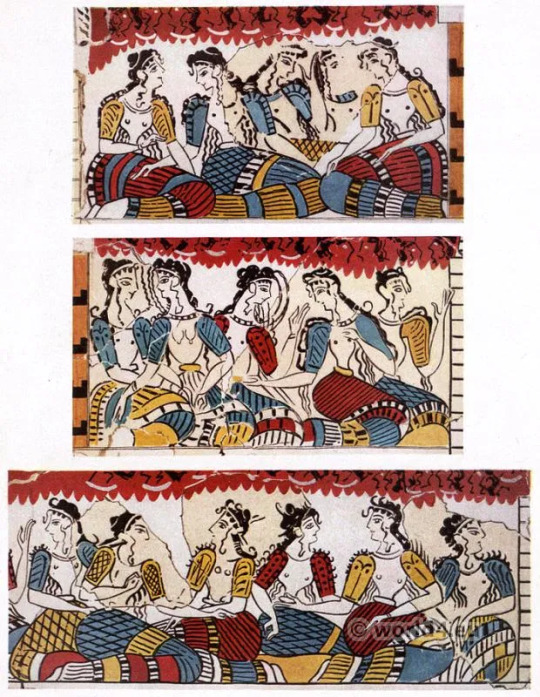
^^^^One of many, many Minoan works featuring women giving their titties fresh air. ^^^^
“Wait a second Pinks! What does this have to do with Ariadne being the Mistress of labyrinths?”
Well you see dear wonderful darling, while we know very little about Minoan religion because Mycenaeans (we will get to those bastards in a second), we do know this:
All the religious figures appear to be exclusively women.
The most important figures of their religion seem to be goddesses as there are few artifacts featuring male gods.
Because of the religion, the culture may have been an equal society or even a matriarchy! Historians who are male aren’t sure.
A frankly ridiculous amount of their temples, including the ones in caves in the middle of fuck-all feature labyrinths. A lot of labyrinths!
Their head god is a goddess! Whose temples have labyrinths and whose main symbols are snakes and bulls. Who do we know is a) the mistress of labyrinths and b) is symbolized a lot by snakes and bulls?
ARI-fucking-ADNE THAT’S WHO!
Ariadne didn’t upgrade by marrying the prince of Olympus! Dionysus wifed up possibly the most important goddess in all of Crete and becoming her boy-toy!
I’m not even kidding, most Minoan depictions of the goddess’ consort features a boy/man who cycles through the stages of death. Dionysus himself in several myths goes through the same cycle - life, being crushed, death, rebirth, repeat. Cycles the consort goes through in Minoan legend depictions too!
Okay, that’s great, but what does that have to do with the Mycenaeans? Why do you want to single-handedly go back in time and strangle the beta-Greeks with the nearest belt?
Everything I just said about Ariadne being a Minoan goddess, the Mistress of Labyrinths being hella important on Minoa, is all theoretical. The Mycenaeans are partially to blame for making it theoretical.
Minoa thrived for 2000 years but it had a lot of issues, mostly caused by natural disasters. Towards the end of their civilization (1500 BC-ish), the nearby island of Thera, today known as Santorini, decided to blow up. The island was a hella-active volcano that when erupted, destroyed a lot.
How big was the eruption? Well when Pompeii was wasted by Mt. Vesuvius, the blast was heard from roughly 120 miles away, 200 km.
The blast on Thera was heard from 3000 miles away. 4800 km away.
Fuck me, the environmental effects of the explosion were felt in imperialistic CHINA.
Holy shit that would waste anybody! And it did! Minoa went from being a powerhouse in the Mediterranean to scrambling to recover from losing 40,000 citizens and who knows how many cities. Tsunamis may have followed the blast, further destroying ports which for a navy-powerhouse of an island nation is a bad thing and the theorized temperature drops caused by a cloud of ash lingering for a while would have destroyed crops for the year.
Minoa was fucked.
The Mycenaeans and all their bullshit made it worse.
Up until a few hundred years prior to Thera’s explosion, Minoan artifacts don’t depict much in terms of military power. Why would it? Crete is a natural defense post. Sheer cliffs, high mountains and a few semi-fortified areas would make it pointless to invade. It’s only when the Mycenaeans in all their bullshit decided to attack/compete that Minoa really needed any army to speak of.
Guess who decided to invade while Minoa was reeling from an incredibly shitty year?
Mycenaea!
Guess who won?
Also Mycenaea!
Nobody knows how this shit went down though because wouldn’t you know it, the Mycenaeans in all their superiority-complex glory decided to destroy most written accounts about Minoa, a good junk of the temples and culturally eliminated most of Minoan beliefs.
Minoa isn’t even the real name of the civilization! It’s just the name Arthur Evans, the guy who re-motivate interest in Minoan archaeology, gave to the civilization because the writings that would have included the name of the civilization were destroyed.
“That sucks!” Fuck yes that sucks! “What does that have to do with Ariadne though?”
Oh ho ho. Strap in because you’re about to be pissed.
Those of us unfortunate enough to be aware of all the bullshit the Christians pulled on the European pagan belief system are familiar with the concept of cultural, religious destruction. There’s a special name for it I don’t know but if I did I would curse it to be absorbed by the horrendous will of fungi.
An example: Christianity was not the most popular of religions amongst the Vikings. A monotheistic religion that is heavily controlled did not strongly appeal to anyone with a pantheon as rad as the Norse one.
In order to appeal to the Vikings, what monks would do is they would write down traditionally Viking stories which up until that point were orally passed down. Beowulf, the story of the most Viking Viking to have every Vikinged, was one of these first stories.
However! Did these monks write Beowulf as closely to the original oral transcript as possible? Of course not! They took liberties! While Norse features such as trolls and dragons and all sorts of Norse magic occur, there is a lot of Christian features added in.
This happened across all Pagan religions that Christianity came into contact with in Europe. Stories would be altered when written down to be more Christian (this happened to the Greek Pantheon too btw), holidays that were Pagan magically lined up with ones the Vatican just happened to suddenly have. Even names of mythological figures were taken and added onto Christian figure names. Consequently, a lot of pagan religions they did this to got erased over time, with many of their traditions and details being lost forever, and the details we do know being tinted by Christianity.
The Mycenaeans were likely no different.
Minoa and Mycenaea were as culturally opposite as can be. Minoa is theorized to be a matriarchal or equal society*. Mycenaea and most of early Greece absolutely was not. In fact, during early stages of their religion where they believed in reincarnation, the Mycenaeans believed the worst thing to come back as was a woman.
Did you get that? With your options ranging from man to ever single animal on Earth, a woman was ranked as beneath literal animals in Mycenaean society.
Fuck the Mycenaeans.
* This is not to say Minoa was without fault, as a society that is matriarchal or equal can still have rampant issues such as privilege, classism, racism, sexism and more, but when history has a shortage of civilizations that didn’t treat women like shit, you find yourself rooting for them more.
What do you do then, when you take over a society that is very much the opposite of a nightmare of a patriarchy? You fold their beliefs into your own to bait them into yours. Going back to the Linear B line about “Mistress of Labyrinths” that line would/could have been an early tactic of incorporating Minoan belief into Mycenaean belief. Other goddesses and gods were made into aspects of Mycenaean gods. Bristomartis, the Minoan goddess of the hunt, would become Artmeis. Velchanos, a god of the sky, would become Zeus.
With more time, the religion shifted more into Mycenaean and eventually into ancient Greece as we know it. Through trade other gods and goddesses would continue to shift and change, some being straight up imported (Aphrodite for example). Dionysus himself changed a lot too, going from a God representing freedom and attracting slaves, women and those with limited power into his cult, to a God of parties for the wealthy.
Theseus and the Minotaur was a myth likely based on a Mycenaean myth based on a Minoan myth that changes Ariadne from an important, possibly the important goddess of an ancient religion and relegates her to a side character in a pantheon so vast that she would be lost within it.
All of this brings us to today. Today, where as soon as work ended I spent most of the day, as well as the past two days, looking up everything I can on Minoan civilization and added it to my notes. Spite is fueling me to write two possible different stories for two different fandoms where Minoa dunks of Mycenaea and it is giving me life. Expect an update within the next two weeks folks as I lose control of my writing life once more.
In summary: Ariadne deserves more respect, fuck the public education system for skipping over the good parts of Greek mythology instead of the r*pey as shit parts, the Mycenaeans can eat my shorts, and a world were Minoa became the predominant power instead of Greece would be an amazing world to live in.
Thank you for coming to my TedTalk. Pink out.

#minoa#minoan#crete#ancient history#ariadne#mycenaea#mycenaean#I hate#HATE#HATE HATE HATE the Greeks so much#homer is a dick#So much spite and curiosity went into this#if I ever get a time machine I will travel to the first years of Mycenaea for the express purpose of burning it to the ground before#they get a chance#the opportunity#to look at Minoa wrong
137 notes
·
View notes
Text
SW OC SPECIES: YAGUARI PART 2/?

((idk how many of these ill end up doing lol but bear with me
as always i don't want people's dash clogged up with super long posts so there is a read more here))
YAGUARI SOCIETY
They are a community based society. They look out for one another and place importance on the community as a whole.
It is extremely common for families to have multiple generations living in one household.
Yaguari do not have gender roles like humans do. They do not believe there is such a thing as “women’s duties” or “men’s duties”. They view both genders as equal. Transgender and intersex people are viewed as close to the divine since their creator god is both male and female.
Majority of Yaguari are monogamous but the ones that live in the desert regions have poly marriages/relationships. The reason why the majority of Yaguari are monogamous is because it is believed that when two people are married they “share a breath” with one another as part of their vows. The two betrothed gently hold each other's faces close to one another and breathe into each other’s mouths. This is symbolic of two souls becoming one. Couples of the same gender can marry as well.
Divorce is looked down upon for the most part. When a couple is married they become one soul and to separate would be to take apart that soul. Reasons for divorce such as rape, sexual assault, abuse of any kind to their spouse or children are viewed as viable reasons for divorce but separation due to irreconcilable differences is not granted.
Yaguari aim to have many children in their families. It is unusual for a couple to have only one or two kids. Couples are encouraged to have children as it is part of the life cycle. They are accepting of adopted children into families and treat them as they would their biological ones. They might be a little apprehensive of non-Yaguari adopted children at first but they eventually take them in as their own just the same.
Couples that are childless are viewed as odd. If the couple cannot physically produce children then they are heavily encouraged to adopt. If the couple made the decision to never have kids, they are looked down upon because they are breaking the life cycle.
Children are watched obviously by their families but also by their community. It is every adult’s responsibility to look after a child that is in their care no matter if they are related or not. Because of this, children call people that are not their mother or father “aunt” or “uncle” out of respect for them. Yaguari typical call an adult their “uncle” or “aunt” but if the person that is taking care of them is a teenager or a young adult then they are called “cousin”.
Schooling is given to every child by law. Education in the Yaguari school system teaches the basics and of course about their religion and history. After their formal education, teens choose what career they want to be in. They go into apprenticeships for the career they choose, (i.e. blacksmith apprenticeship, acolytes for priesthood, combat training for warrior, etc.) It is not uncommon for a Yaguari to have had multiple different jobs within their lifetime since their lifespans are extremely long. If a Yaguari has had the same job for most of their lifetime then they are just viewed as devoted to their work and it is an admirable trait.
YAGUARI WARRIOR
A Yaguari’s fighting style is ruthless and bloody. They are officially taught combat in their late teen years (after their education has ended).
The warrior is taught to dismember their victims, strike major artery points to make their opponents bleed profusely, and behead them. They are also taught to be agile and to change their fighting style on whim to keep their opponent on their toes (see here change in fighting style connects to change = next stage = next cycle). They are also taught to claw their victims. Their jaws are said to be powerful enough to snap a bone. One of the most notorious moves of a Yaguari warrior is to bite their opponent’s neck so hard that they die from blood loss.
Top warriors before a battle take a sacrificial animal, bleed it to death and place their fingers in the blood to mark their faces from forehead to tongue to chin. They do this because they are gaining the life force from the animal as a blessing from their gods for the battle. During the battle, the other warriors make their opponents bleed and mark themselves the same way with the enemy’s blood. This is symbolic of taking the enemy’s life force or abilities and storing it into the Yaguari warrior.
Warriors are noticeable in their society because they wear their iconic gold torc necklace. Their torcs are made of a gold-like material, not super heavy but still has some weight to it. The torc has inscribed images on it that are representative of the merits that a warrior earns in their career. Some warriors hand carve these symbols themselves or they go to a goldsmith for help. This torc is highly prized and is a symbol of status. It sells extremely high on the black market on other planets and systems. Though the trick is, to obtain a Yaguari’s torc is to kill them and a warrior is notoriously hard to take down.
Warriors are taught to keep fighting their opponent till their dying breath. They are taught not to stop if they are injured or even have a limb missing. The belief is if you are still breathing than you can still fight.
OTHER CAREERS
Being a warrior is not the only career option although it is deemed as the most honorable, prestigious one. The next career that is viewed just as highly is priesthood. This is because they are viewed as being close to the divine beings and divine realm. They are the ones taking care of the temple, performing ritual sacrifices, officiants at weddings and funerals, other ceremonies for the gods, performing bloodletting rituals, etc. Priests can be any gender, marry and have children.
Another career that Yaguari view in a good light is the farmer/rancher because they are close to nature and provide food for the community.
There are numerous other careers in their society just like any other culture. It is a belief that everyone’s place in society is important yet there are some people that think some careers are better than others.
6 notes
·
View notes
Text
Life is a Pandora's box and the hope within Prometheus
Is mythology merely a collection of fascinating legends, or does it have a purpose? Mythology is concerned with both the past and the present. It illuminates the path. Mythology explains how emotion may take control of a person. We can clearly perceive that the greatest enemies of humanity are passion, ambition, hatred, selfishness, and greed. A myth is an image with which we try to make sense of the world,” says Alan Watts. Beyond your imagination, these stories tell us that "the limits of life are beyond what you only know, learn from your past and guide your future." I can hear this whisper. "Myth and nature are the two great garments of the world; nature is the vibrant green garment that covers the planet, and myth is the multidimensional, multi-coloured fabric that constantly covers human culture."(Michael Meade) We can understand the meaningful expression of these words of Michael Meade more easily by expanding our knowledge pool. Nature is a gift given to the world, and man is the other gift that completes the world. He can contain every colour in his soul and turn the world into a work of art, or he can object to other colours and choose only black and go towards the depths of darkness. I would like to tell you about mythological stories that have inspired me. Mythology's brightest stars are Pandora's box and the Prometheus legend.
According to a legend, Zeus created Pandora, the first woman on Earth, as a punishment for humanity. This punishment for humanity was devastating and unkind like the great flood of Noah. When humanity forgot about its creators or ignored the gods, the gods were reminding themselves of such punishments. Zeus gave Pandora a box that she should never have opened. This box symbolized the personality of women. There was so much evil in the box, such as malice, hatred, anger, murder, and greed. If the box was opened, these evils would spread to the earth, and Pandora's curiosity prevailed and she opened the box. All evil has spread and swept the world. The great disaster was now within humanity. The box, which Zeus knowingly gave to a woman's curiosity in this story, was a great scourge for humanity. Besides all these evils in the box, there was only one good thing for humanity and that was hope. Mankind has never abandoned hope, and hope has been his only consolation. Instead of blaming Pandora, who opened the box, one should consider Zeus, who sent her for this purpose. For poor Pandora to succumb to her curiosity was the most unlikely thing that could happen to a mortal, but Zeus, who knew this, also knew what would destroy the human race, if you ask me, Zeus survived these evils and his jealousy became his most dangerous weapon. In this regard, Zeus, who continued this ugly reign like Cronus, who ate his sons so that his father would not heir to the throne and his power would not decrease, always succumbed to his feelings. Pandora's curiosity was an invisible mistake compared to what Zeus had done. "Hope? Hope is the last evil!" says Nietzsche. The fact that the last thing humanity clings to is hope, which actually informs them that it is the greatest evil done to them, but without hope, there would be no real reason for people to hold on. Of course, the thing that hurts the most is the disappointment caused by the lack of hope, but no matter how tired one gets, it is also important to be able to fight with the last hope left in one's hands and rely on that hope. Therefore hope, which Zeus saw as a huge bad power, was actually a light for humanity.
It would not be enough just to blame Pandora. For Zeus, his main target was Prometheus. Prometheus had been punished many years ago, by setting fire to humanity and making it higher than God. Zeus tied Prometheus to the hard rock at the foot of the Caucasus Mountains by force and violence with unshakable and unbreakable chains. Prometheus had helped Zeus in the battle with the titans, and this favour was quickly forgotten. Zeus' vengeance was enough to make him forget this great goodness. Zeus had insolence, arrogance, egocentric coarseness of human nature. He could have killed Prometheus instead of chaining him, but Zeus couldn't because he had an interest. There was a prophecy told to him. One day a boy would be born and take his throne from him. and only Prometheus knew who the boy's mother was. Zeus sent Hermes to find out this secret, but Prometheus resisted and did not tell the secret, despite all the torture, albeit in chains. showed that there can be a solution if there is willpower. At that moment, the god of gods left Zeus helpless. Prometheus was released generations later. Chiron was ready to die for Prometheus. Hercules slew the eagle and unchained Prometheus from the rock. We realize that even the enmity does not last forever when Zeus says that now this punishment may be enough and will set him free. Prometheus is the strongest character in this story, he is the symbol of justice and he represents never surrender, no matter how much pressure, no matter how to torture. While Prometheus was being held captive in chains, a beautiful and mysterious girl would visit him. This girl's name was IO. They would chat with Prometheus and talk about Zeus. Zeus falls in love with this girl and this love does not escape Hera's eyes. Suspecting Zeus, Hera assigns her servant Argus, who has 100 eyes, to keep him comfortable and control him. Knowing that his lies are useless, Zeus is watched by Argus even while he sleeps. Desperate Zeus turns her into a poor ugly starving animal to get close to her love. However, Argus still does not stop watching him. Finally, Zeus commissions his son Hermes, the messenger of the gods, to kill Argus. Hermes played sweetly upon a pipe of reeds. Argus was pleased at the sound and called to the musician to come nearer. Hermes made some of the hundred eyes sleepy, but some were always awake. Finally, Hermes killed him. If you believe that poor IO has been saved, you are mistaken about Hera's rage and envy. Hera sent a gad-fly to plague her, which stung her to madness. When IO told this to Prometheus, he tried to comfort her. She ran along the seas and lands. This part of the sea was called Bosporus. As she reached the Nile, Zeus would restore her to her earlier human form. She would bear a son called Epophus. IO’s descendant would be Hercules who was the one of the greatest heroes. Prometheus helped them. Hercules helped Prometheus at the same time, he gave Prometheus’ freedom. The good are rewarded. We realize that the evil characters aren't always the heroes, and that the good guys will return one day.
Gods and goddesses are another shape of humanity of current. They used their power to destroy somethings like big cities. Even today power wars have not finished. Someone who feels powerful wants to be mightier. Human or gods is trying to force somebody to abdicate. We are aware that a desire is worth more than a drop of blood. We see that neither hostility nor friendship last forever. Zeus who was the god of gods and Prometheus who was the saviour of man were the best friends, but Prometheus’ giving fire to humanity as a gift and knowing a prophecy about Zeus turned this friendship into enmity. At the present time, good friendships can become enmity for any reason. In past, Zeus left Prometheus in despair. Jealousy, the main concept that never changes in both present and past, played a role in almost every event. Jealousy creates slyness as a snake and cunning as a wolf. Today, every person who is jealous definitely brings evil things whatever happens. We have learned from Hera how jealousy is dangerous when it is combined with power. She used her power whenever Zeus fell in love with another woman. Beautiful Psyche’s sisters have showed that jealousy is disease and it spreads as fast as fire. They came her home and jealousy wrapped them like a fire. When Pandora opened the box, so many evil things showed up, but at the same time hope approved itself. People never abandon to hope. We are still aware that everything which is bad has a solution and we can defeat anything if there is hope. Hope is really the cure for everything. Just believing is enough to overcome most things. The eyes in the hearts should always remain open. Living as if a person would never die gives rise to endless desires. Today, many people have these desires; however, you can restrain your desire and everything is in your hands. You can abuse this opportunity and you can also use to good things. If a person is defeated by her or his anger and ambition, this short life swallows her or him. Mythology enables us to see what the truth or wrong is, the truth or evil is, and deceptions or deaths are. It helps us to know people who are captured all emotions. It shows that history always repeats and cruelty does not change in both past and present. Fate always overcomes everything. This never change in past or present. History leads to understand what truth is and what wrong is. This bridge always provides to understand the relationship between powerful and powerless. We are actor in own stage. We should play the best play for life. We should stay alive. It does not matter how it will be because we are not permanent in this life.
-Tanzmitmirsblog
#mythical creatures#mythology#greek myth poetry#greek mythology#english literature#writing#essayist#essay writing#read#long reads#writersnetwork#young writer#poetry#literary#mymind#bloger#literature#novel#educational stories#pandora#prometheus#hope
8 notes
·
View notes
Note
Same anon as before: Holtz for the headcanon meme + 8, 9, 36 + 42? (:
Oop, I totally missed that you sent this one! Here you go:
8. Favorite indulgence and feelings surrounding indulging
This girl is a truly committed hedonist, omfg. She lives her entire existence dancing on the thin line between life and death, laughing in the face of God. I truly believe Jillian Holtzmann is convinced she isn't capable of dying and she'd like to see anyone try. I know a lot of people within the fandom like to see her as having a high sex drive and an active sex life, but I don't see it myself - I think sex makes her nervous and she avoids feelings-related things that make her nervous as much as possible. If she has a favorite indulgence, it's food, and she eats whatever she wants, whenever she wants.
9. Makeup?
I read Holtz as a nonbinary lesbian tbh, and as a nonbinary lesbian, gender feels very alien to her in general. She simultaneously sees herself as a woman and she doesn't, and she really doesn't know how to navigate it. Where makeup is concerned, she prefers makeup that allows her to exist in "stealth mode." By that, I don't mean that she prefers nude, natural-looking makeup. I mean she likes the kind of makeup that is visible to women (specifically queer women) and either confuses or evades the attention of men. The lipstick she wears in the film is a rose pink, not a natural color if you know what you're looking at, and she also sports winged eyeliner. It's the kind of look that men would look at and think she's not wearing any makeup, but women would recognize the effort that actually goes into her look. That's what she wants: to be invisible on the radar of men while appealing specifically to a queer female gaze.
36. What makes them feel guilty?
Holtzmann's fight-or-flight response is freeze. It's uncomfortable enough for her when it happens in social or emotional situations, because she'll freeze up and shut down, maybe even cry because it's so humiliating to be caught on the spot unable to function when she's overwhelmed. But where it makes her feel guilty is when it happens during busts and battles where the rest of the team is present, because she knows it could endanger them. The others actually have to spend some time reassuring her that's why there are four of them - to be able to step in and protect each other, so they're not relying on anyone being on perfect form all the time.
42. Hobbies?
Holtz is adept at both sewing and embroidery!
Think about it: how do these women who have been shunned and written off as nutsos by the city at large manage to get these awesome customized jumpsuits in the very short interim between their first bust at the theatre (where they had no logo or name patches) and the next time we see them out? Which member of the team has already shown an interest in customizing their things (car, motorcycle) with the logo and aesthetic of her newfound little family she's so proud of, to the point of wanting them all visibly united under that symbol?
Holtzmann is the creator of the No Ghost patches and the name patches that later adorn their uniforms, and she's the one who lovingly sewed them on 100% without asking the other girls first. She's good with her hands in a lot of ways, and this is one. She's somewhat lowkey / secretive about this being a talent of hers because it's so traditionally feminine, but she's REALLY good at it and definitely the person you call if you need a custom fit.
13 notes
·
View notes